Urawa Red Diamonds haven’t enjoyed the best of starts to their J1 League campaign as they currently find themselves down in eighth place, nine points behind current leaders Vissel Kobe. It was announced in December 2022 that Maciej Skorża would take charge of The Reds ahead of the 2023 season.
Skorża’s managerial career has been incredibly eclectic thus far, after spending ten years working as a youth coach or an assistant manager. He was given his first taste of senior management in 2004 at the now-dissolved Polish club, Amica Wronki. Most recently, he guided Lech Poznań to the Ekstraklasa title in 2022.
Despite a questionable start in the league, Urawa Red Diamonds have already had a taste of success as they recently beat Saudi Arabian team Al-Hilal to claim their third AFC Champions League title.
This tactical analysis will focus on the tactics that Skorża has brought to Urawa Red Diamonds and how they play out in game situations. We will perform an analysis of the strengths and weaknesses of Skorża’s tactical setup and look at what the data tells us about how The Reds compare to their fellow J1 League teams.
Preferred formations
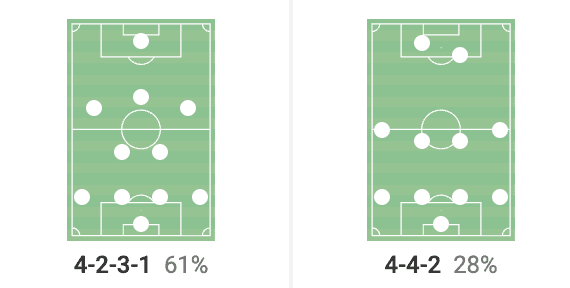
As we can see from the graphic above, Skorża mostly favours a 4-2-3-1 formation. He also has used a 4-4-2 set-up this season, mostly in the AFC Champions League, which we will talk about in this analysis. Urawa are not a heavily possession-based team. According to the statistics, they average 54.63% possession per 90 in the league this season. So, whilst they see slightly more possession than their opponents, we are not talking about a team that is emulating Manchester City or any Pep Guardiola team.
Interestingly, if we isolate the stats of the AFC Champions League final against Al-Hilal, it becomes apparent that Urawa Red Diamonds completely ceded possession. Over both legs, they averaged 29.84% possession, indicating that their game plan was centred around being a counter-attacking team.
How did Urawa Reds win the AFC Champions League?
This section of the tactical analysis will be something of a mini-analysis of how Urawa Reds became AFC Champions League winners for the third time in their history. Upon looking at the data available and watching the footage, it became apparent that Skorża sent his team out with a specific game plan in order to cope with Al-Hilal’s intense pressing tactics.

Firstly, let’s focus on the two goals from the 1-1 draw in the first leg. In Figure 1.1, Salem Aldawsari is highlighted as his positioning is incredibly important as it is key to Al-Hilal taking an early lead in the tie. As we can see from Figure 1.2 below, Skorża sent Urawa Reds out in a 4-2-3-1 formation that set up as a 4-4-2 in the defensive phase, with the intention of staying compact, soaking up the pressure and looking to hit Al-Hilal on the break.
Moreover, Urawa had a PPDA of 26.37 in the first leg, therefore, we can see that they were more than happy to let Al-Hilal pass the ball around. Urawa’s biggest focus was on their defensive structure and ensuring they stayed in the tie ahead of the second leg at home.
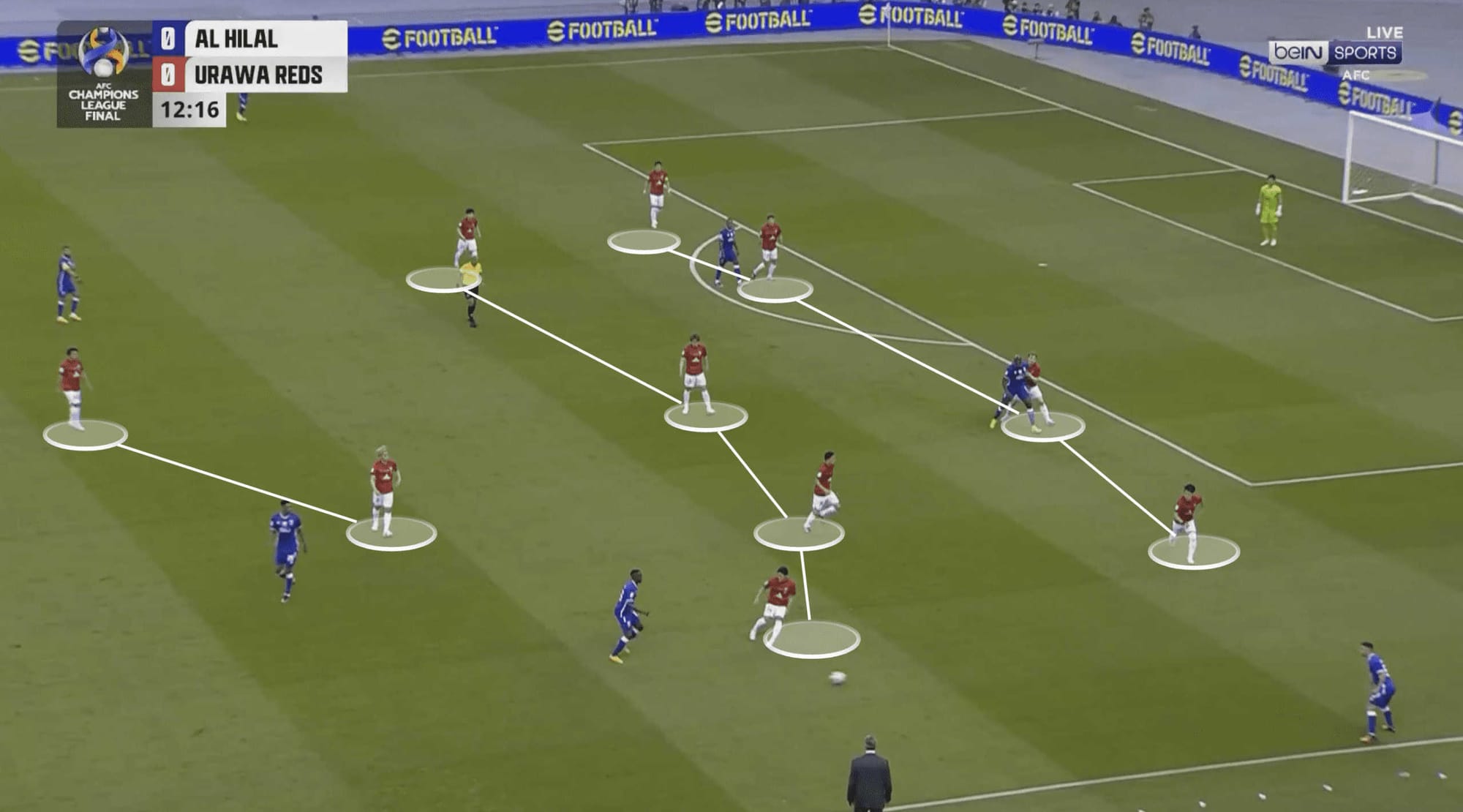
Urawa Reds displayed a high level of compactness in their defensive phase of play, leaving little to no space between the lines as they aimed to disrupt the passing lanes. However, their decision to remain so compact and narrow allowed Al-Hilal to exploit the wide areas and find opportunities to advance.
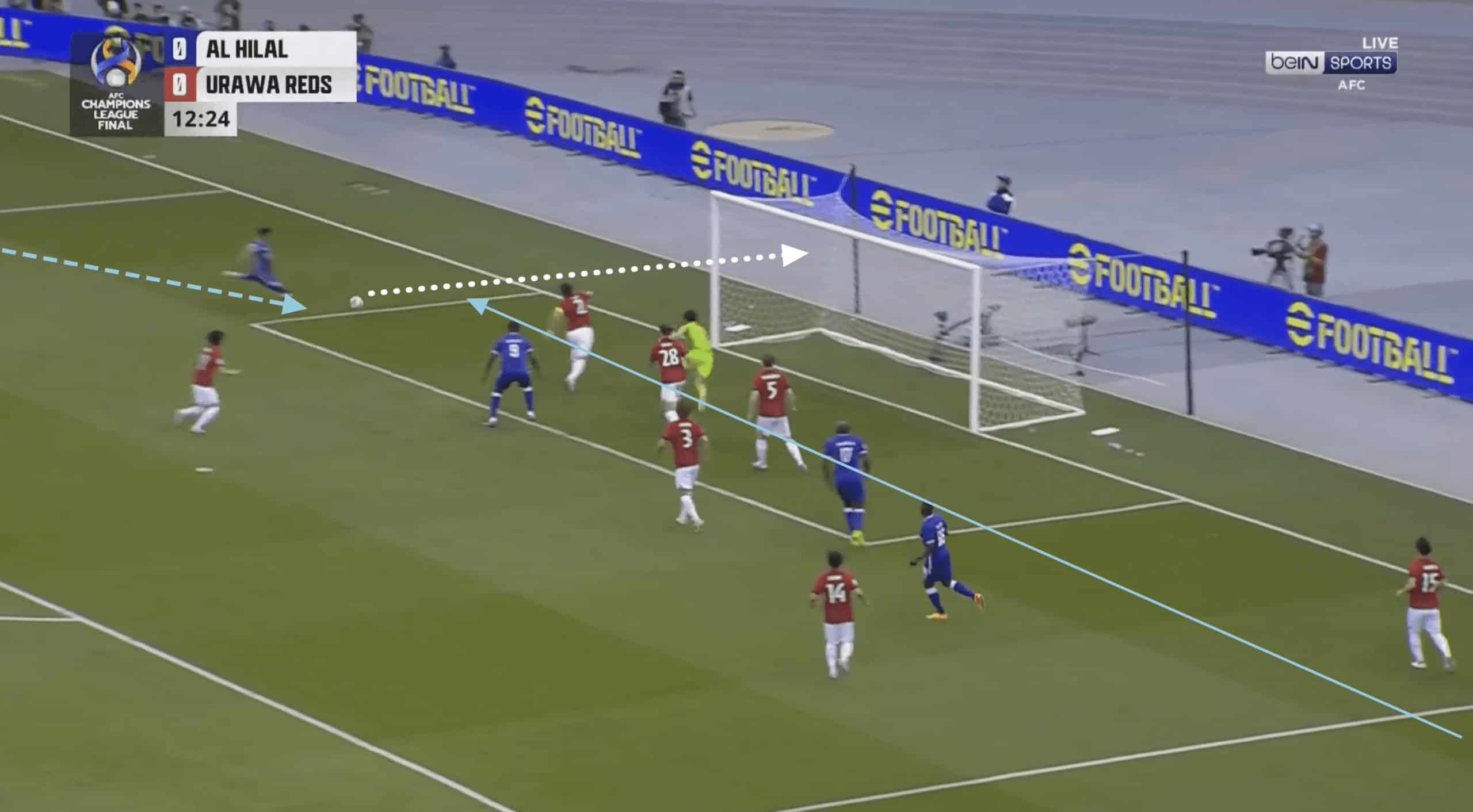
Eight seconds later, the attack unfolded as Al-Hilal skillfully manoeuvred the ball towards the wide areas, resulting in a well-driven cross being fizzed into the penalty area. Despite Urawa having a numerical advantage in terms of defenders, the ball successfully reached Salem Aldawsari, who calmly tapped it into the net, giving the visiting team a 1-0 lead.
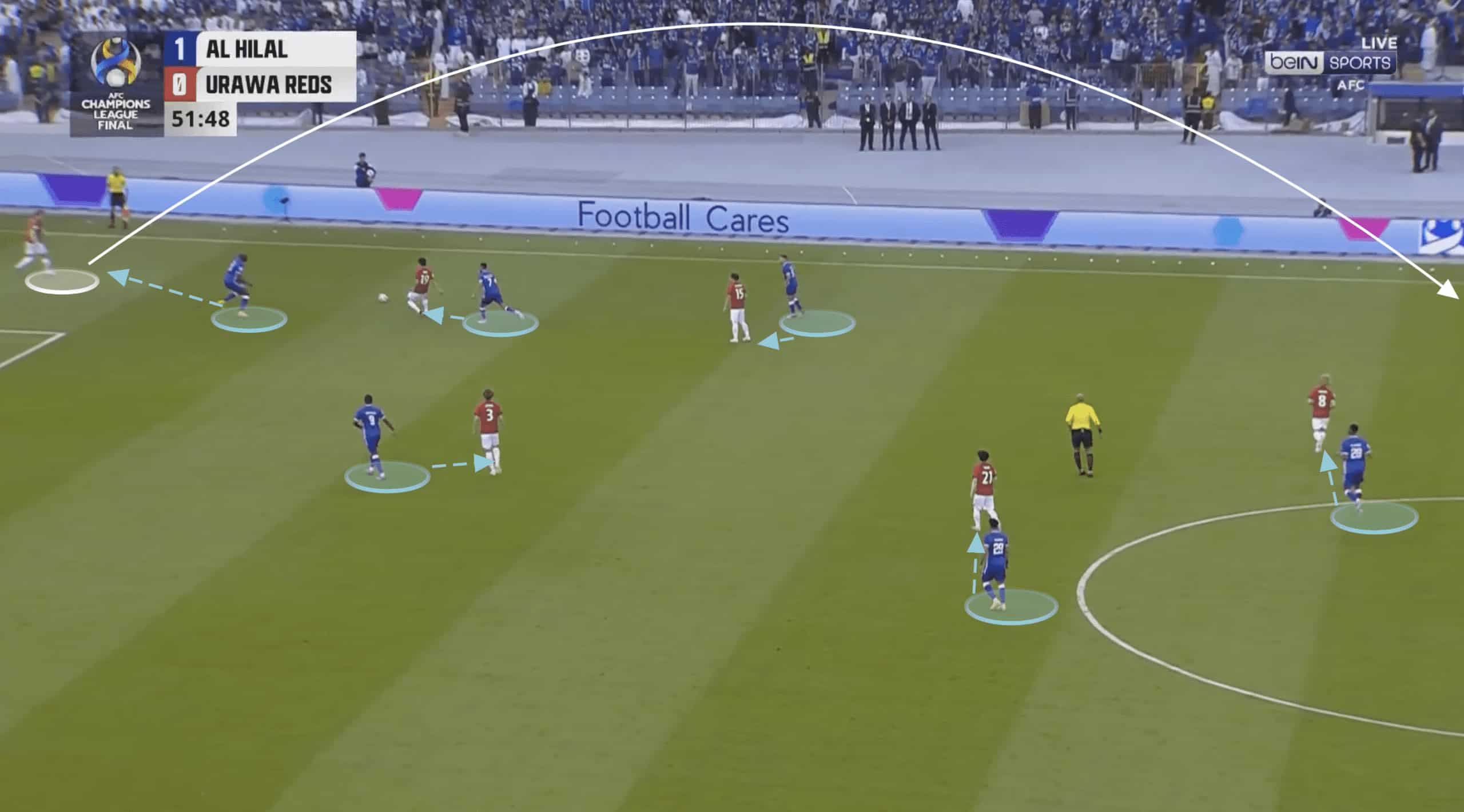
Furthermore, if we turn our attention to Urawa’s equalising goal, we can see here in Figure 1.4 just how intense the Al-Hilal press was. Whilst their pressing was intended to stifle Urawa and cut off their ability to play through the lines, Skorża’s team were well prepared for this.

Consequently, the team was forced into playing it long, which enabled them to bypass the Al-Hilal press, as shown here in Figure 1.5. Yoshio Koizumi receives the knocked-down ball and plays it backwards. Tomoaki Okubo then receives the ball and carries it forward after turning. Meanwhile, Shinzo Koroki identifies a gap in the Al-Hilal defence and makes a run through it.
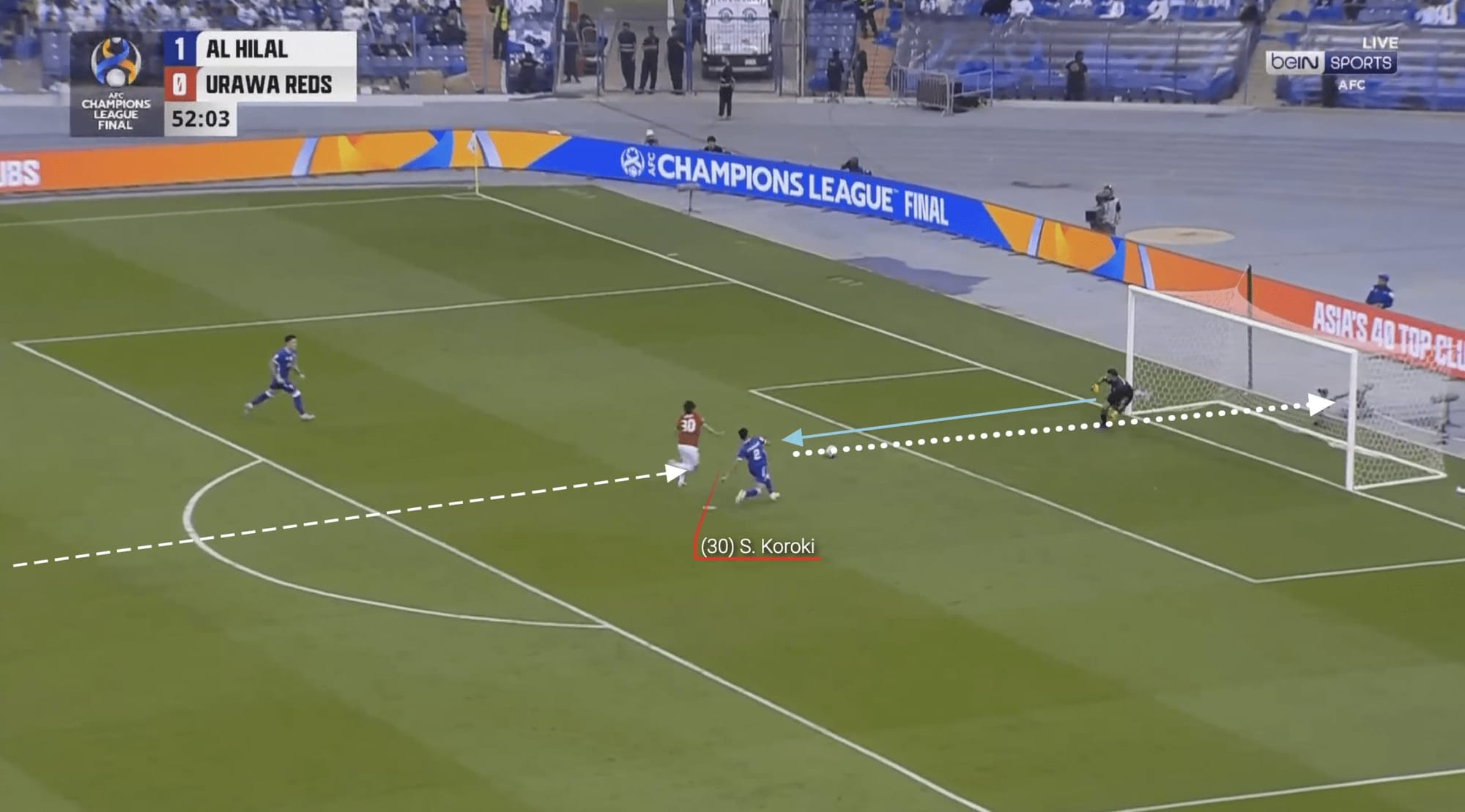
The ball played through in search of the Urawa forward deflected off a defender and struck the post, bringing The Reds a fair bit of luck. We can see that Koroki deserves credit as he persisted with his run forward and positioned himself to place the rebound beyond the goalkeeper.


Now, let’s shift our focus to the second leg of the AFC Champions League final. Urawa adopted a 4-4-2 formation and actively employed a higher press this time. While they remained cautious, there was a noticeable increase in their intent to press on specific occasions, as depicted in Figures 1.7 and 1.8. During this game, The Reds recorded a PPDA of 14.39, which does not indicate a high-pressing tactic but represents a significant decrease from the previous game.
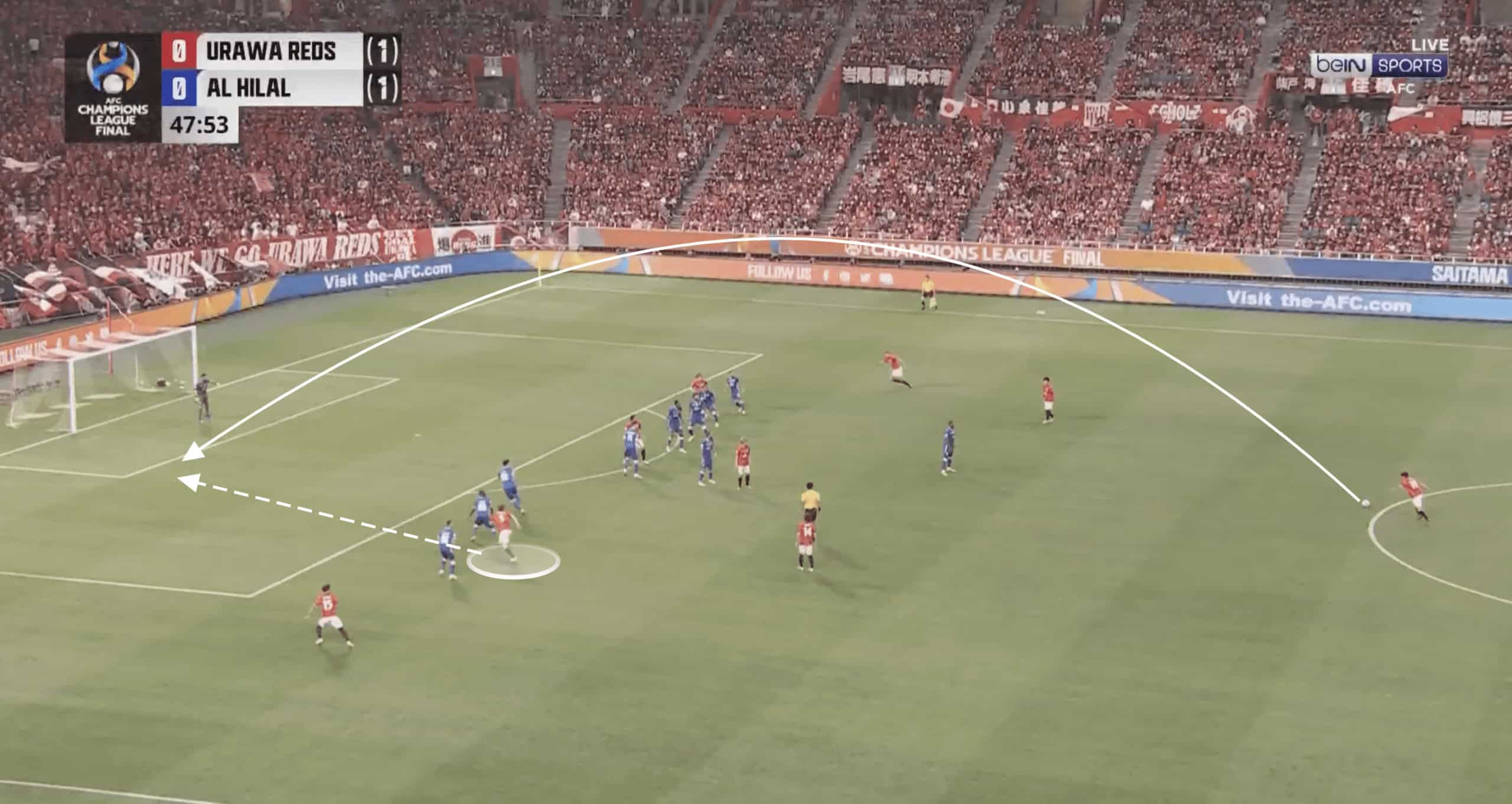
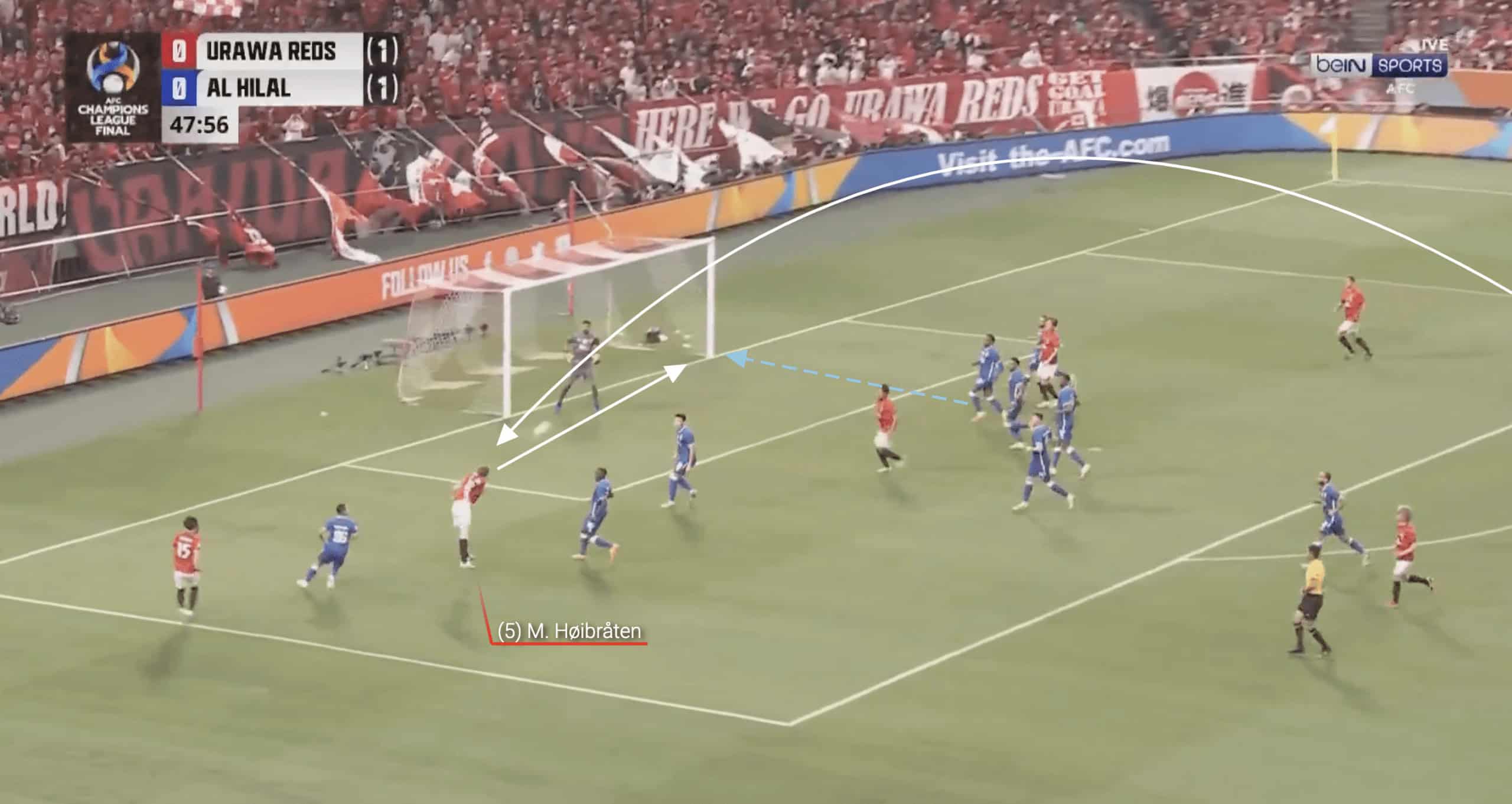
In this game, only one goal was scored, and once again, there was a significant element of luck for Skorża’s side. As shown in Figure 1.9, Urawa was awarded a free kick. A long ball was delivered into the penalty area, and Marius Høibråten successfully outperformed his marker in the air. He headed the ball across the goal, and unfortunately for Al-Hilal, André Carrillo inadvertently turned the ball into his own net during an attempted clearance.
To secure victory in the AFC Champions League, Skorża adopted an extremely pragmatic and cautious approach, particularly evident in the first leg, resembling a performance reminiscent of Jose Mourinho‘s style. The Reds anticipated Al-Hilal’s high-pressing tactics and cleverly utilised them to their advantage. As a result, they baited Al-Hilal into pressing aggressively, only to exploit the situation by playing long balls over the top. This strategic manoeuvre effectively bypassed the majority of the Al-Hilal players and created opportunities for Urawa to generate goal-scoring chances.
How does Skorża’s tactical set-up in the league compare?
We’ve seen how Maciej Skorża guided Urawa Red Diamonds to the AFC Champions League title. Now, let’s turn our attention towards how Skorża tactically sets the team up in the J1 League. When recently asked about how he wants Urawa to play, Skorża replied:
“I want to create many chances and play aggressively”.
So, we can already infer that the way Urawa Reds play in the league is significantly different to how they set up in the AFC Champions League final.
Inverted runs and freedom for fullbacks
Upon watching Urawa Reds this season, it becomes very apparent that much of their attacking play is structured around players making inverted runs from the wide areas, especially the fullbacks.
The fullbacks inverted runs into midfield and beyond can benefit the team in several ways. Firstly, it allows them to overload the midfield by adding an extra player, creating numerical superiority and allowing for better control of the game. Their presence in midfield provides additional passing options, facilitating quick and efficient ball circulation.
Secondly, these runs create space and width on the flanks. As a result of the fullbacks moving into midfield, the flanks open up for the wingers, wide midfielders or forwards to exploit. Subsequently, this dynamic attacking option stretches the opposition’s defence, making it harder for them to defend effectively. Additionally, it opens up passing lanes through the middle, which can be utilised by central midfielders or forwards.
The combination of play between fullbacks and central midfielders confuses the opposition defence and creates opportunities for crosses or cutbacks into the box. Moreover, these overlapping runs can drag defenders out of position, creating gaps that can be exploited by other attacking players. Their unexpected movement adds an element of surprise and unpredictability, forcing the opposition to adjust their defensive shape. This disruption can create gaps or mismatches that can be exploited.
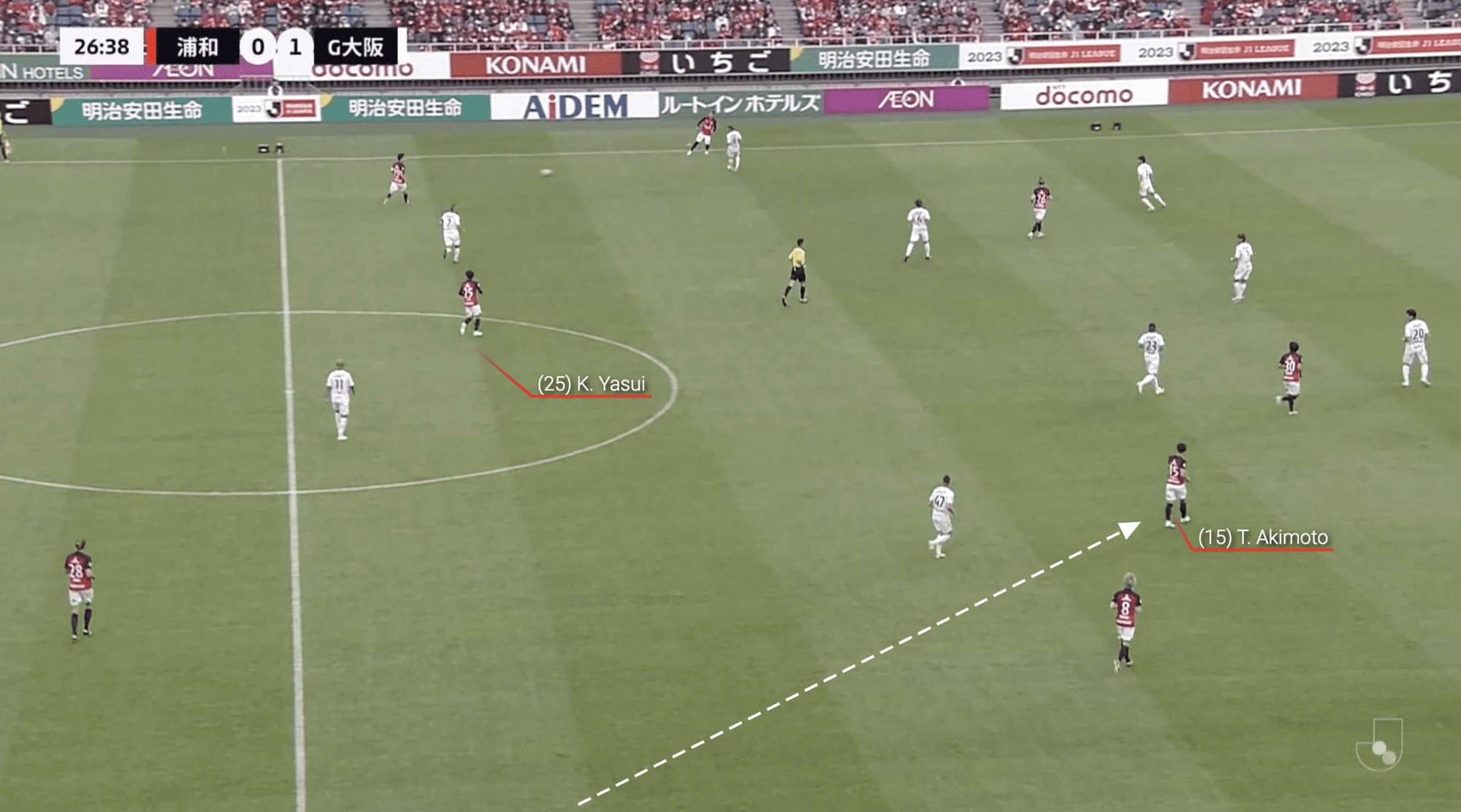
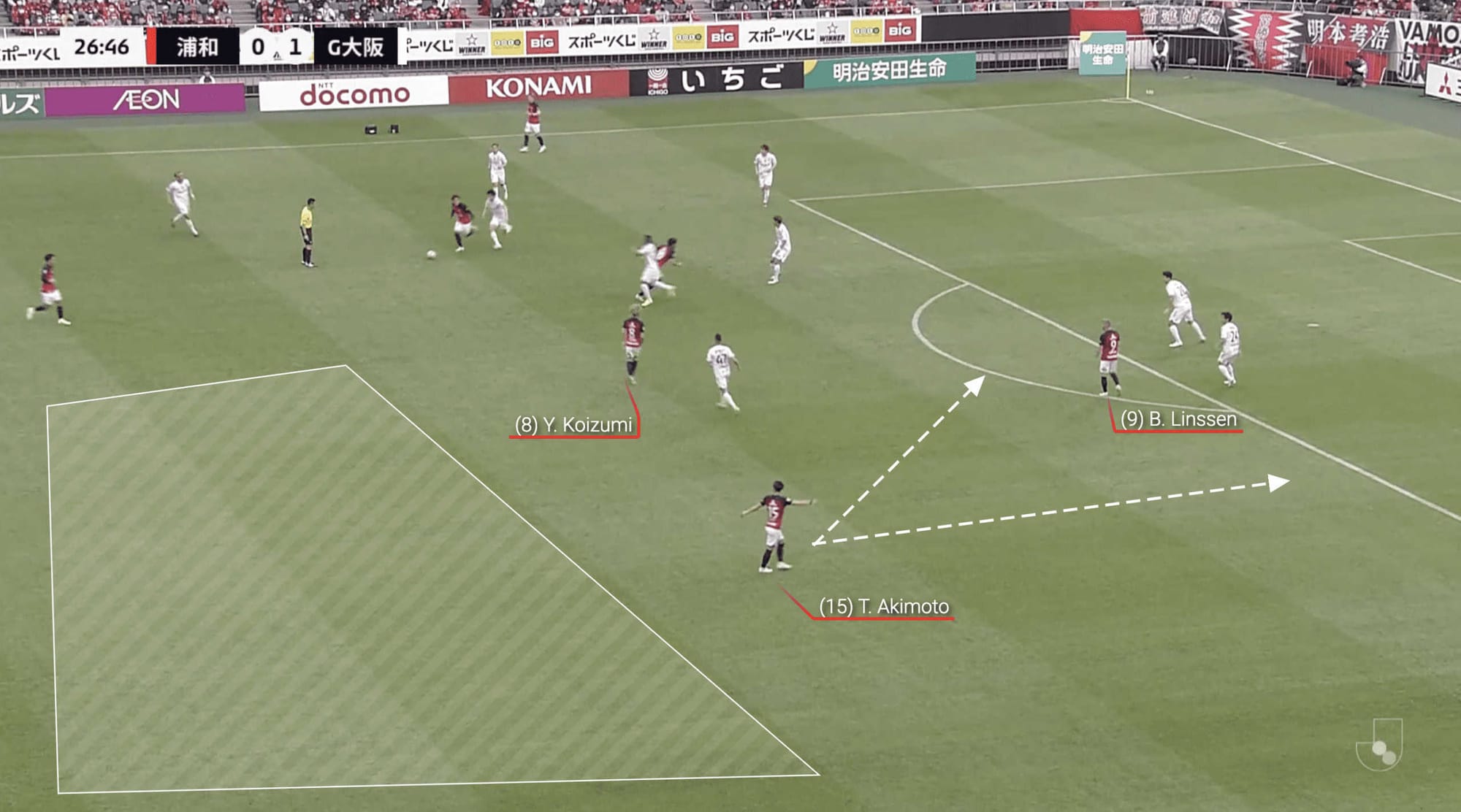
We can see Takahiro Akimoto, who has been playing as a right back for Skorża of late, has made a run in from the right wing and taken up a position alongside Koizumi in the attacking midfield area. It is worth noting that Akimoto is primarily a left back or left winger so this could have heavily influenced his desire to make more inverted runs into central areas.
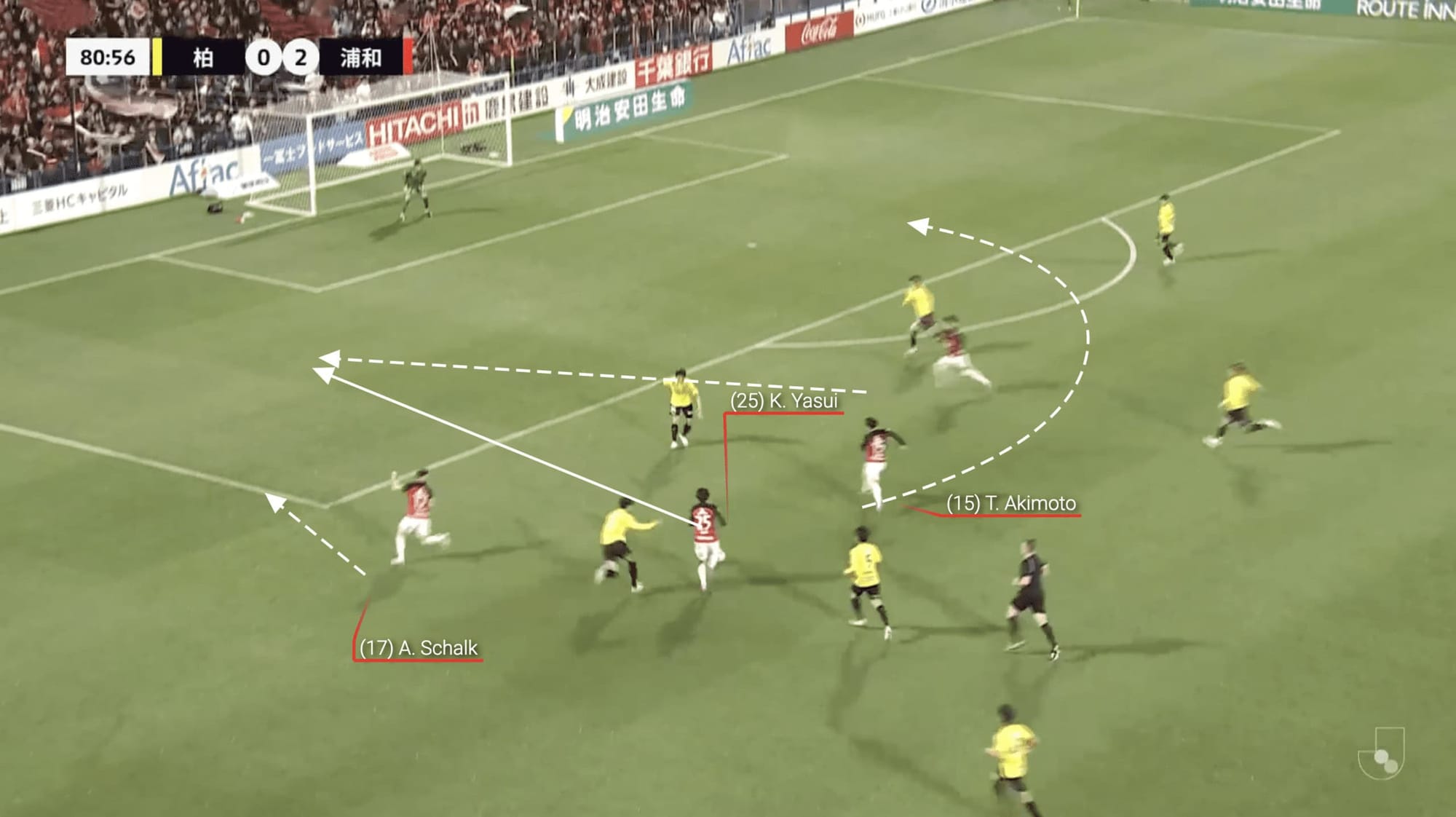
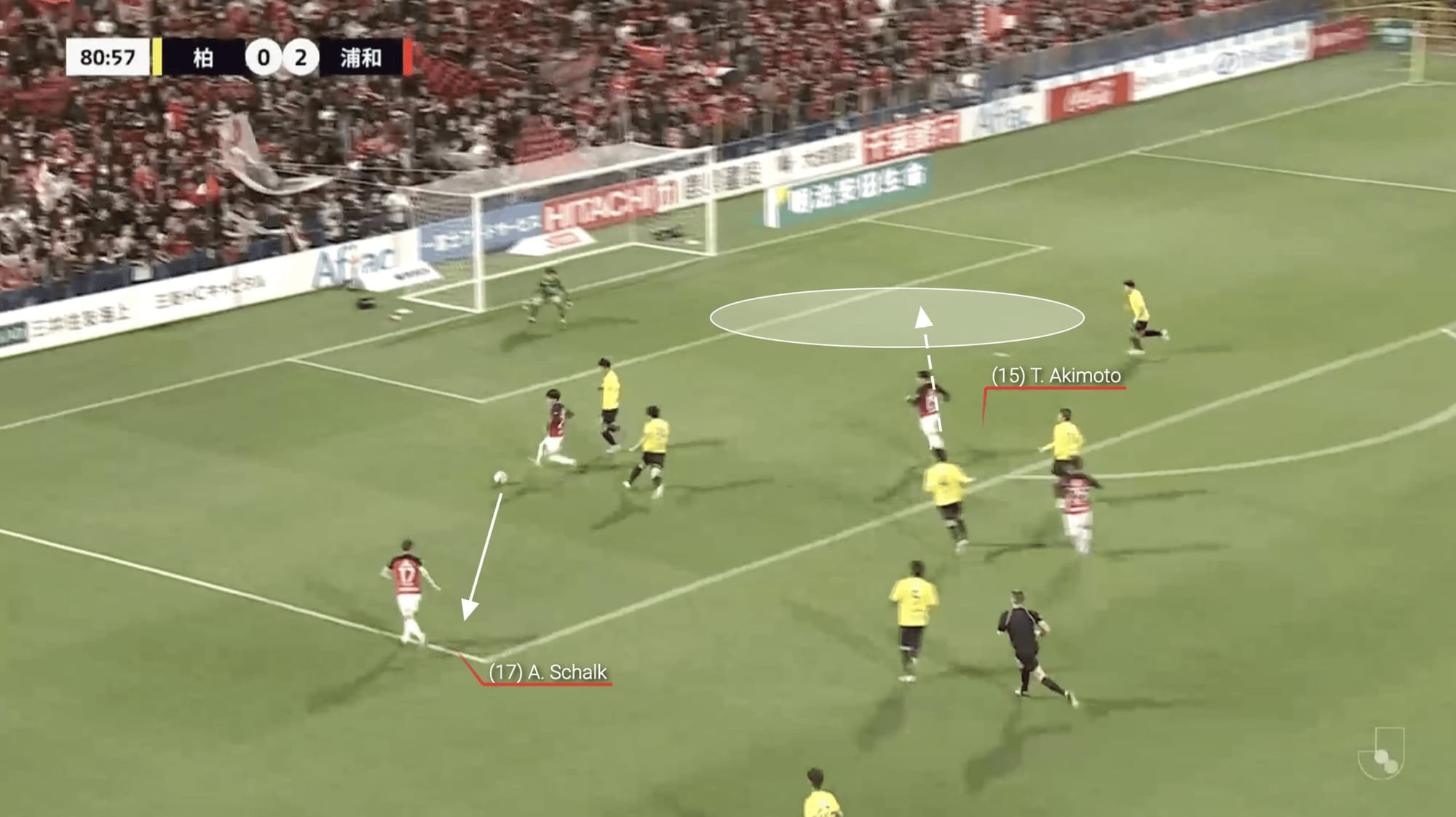
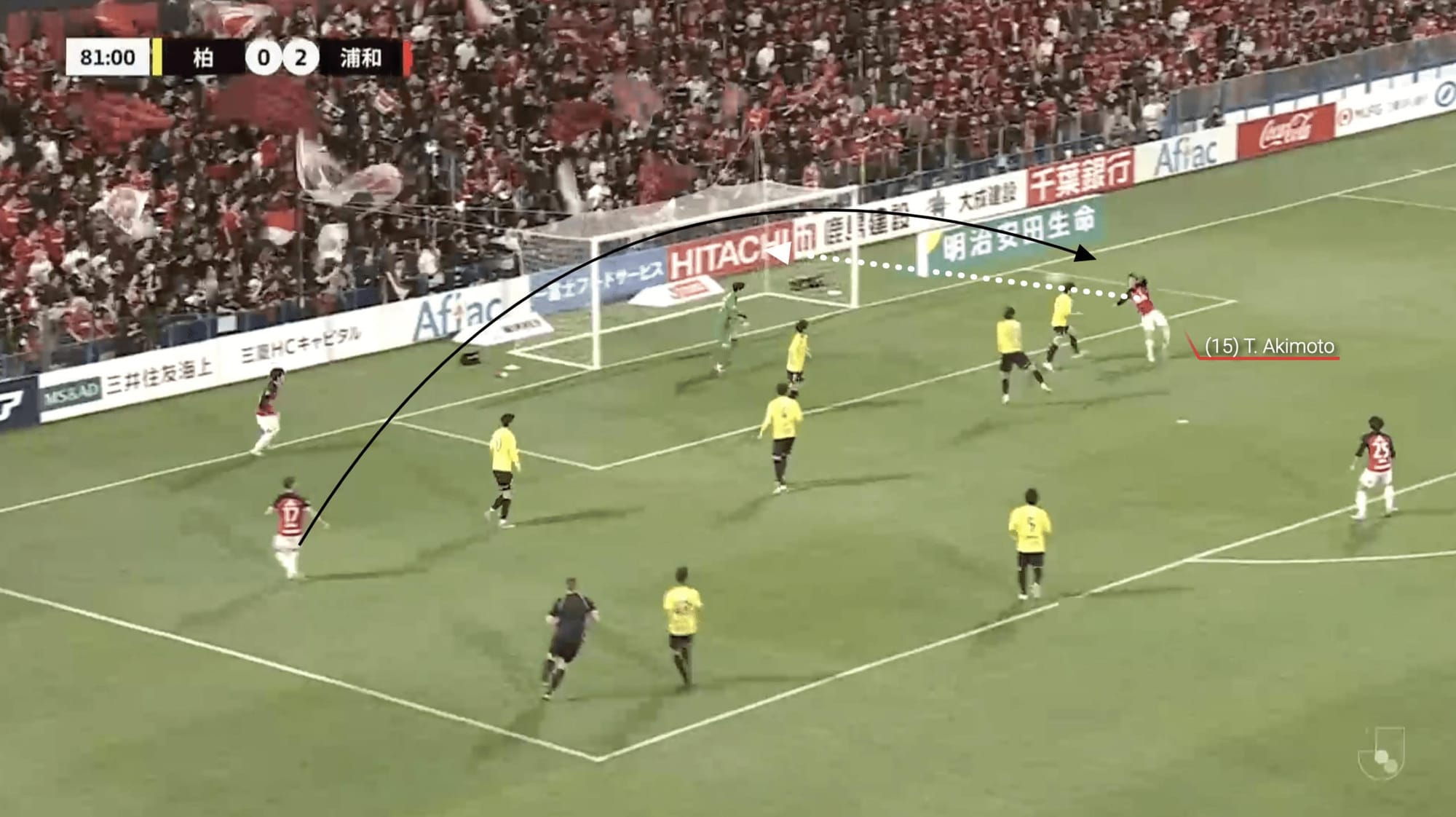
Here, we can see the Urawa Reds players initiate a counterattack, we can see how Kaito Yasui carries the ball into the attacking third. Akimoto is also involved in the counterattack and makes a run into the penalty area as Figure 2.3 demonstrates. The ball is worked back to Alex Schalk who plays a cross towards Akimoto who acrobatically adjusts his body orientation to score Urawa’s third goal of the game as we can see in Figure 2.5.
Counterattacks rely on swift transitions from defence to attack, and Akimoto helps to initiate the transition in this scenario by quickly moving forward and making a run to support the attack. His involvement adds a level of unpredictability to the team’s offensive play which catches the opponents off guard and creates a well-worked goalscoring opportunity.
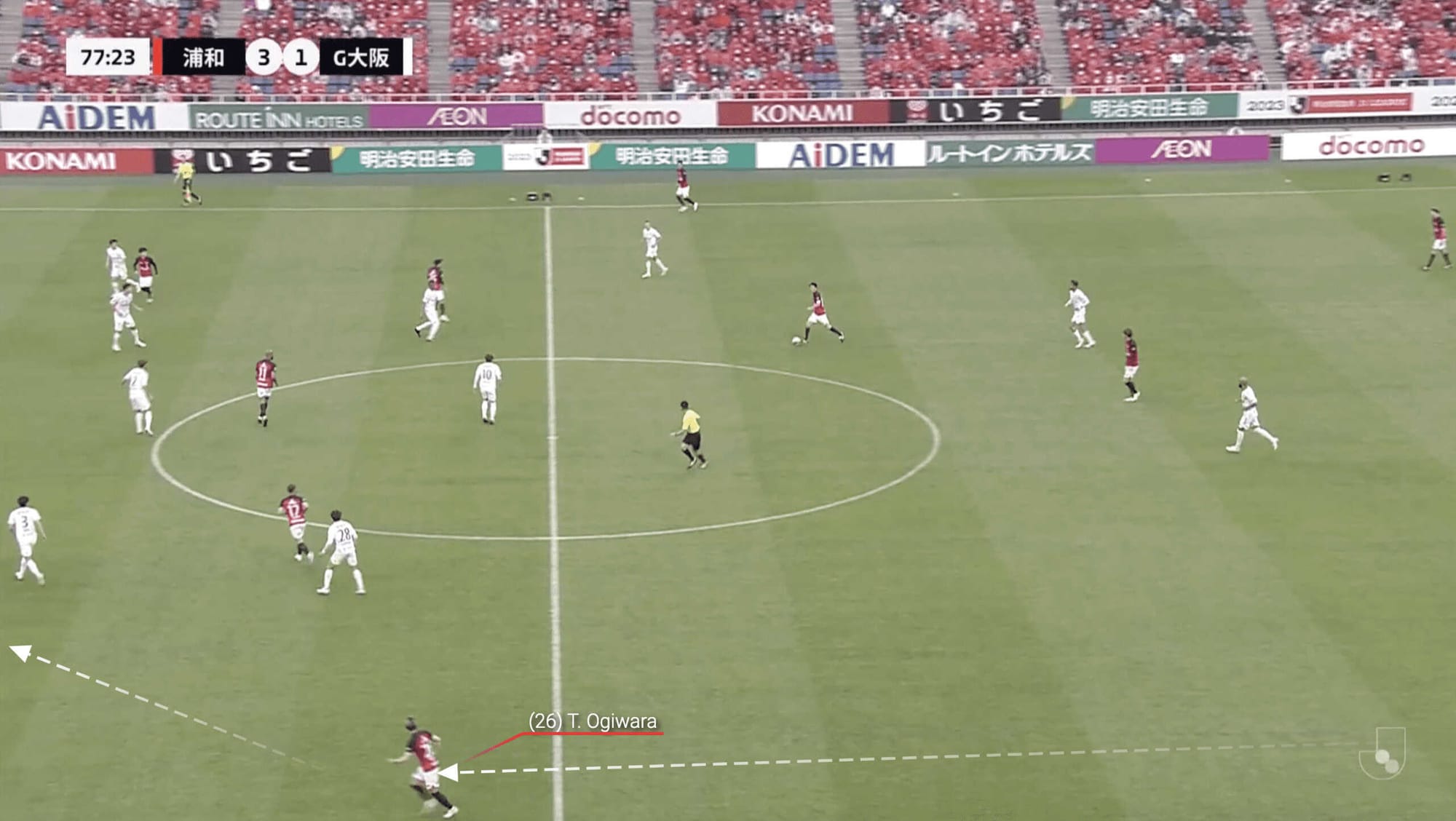
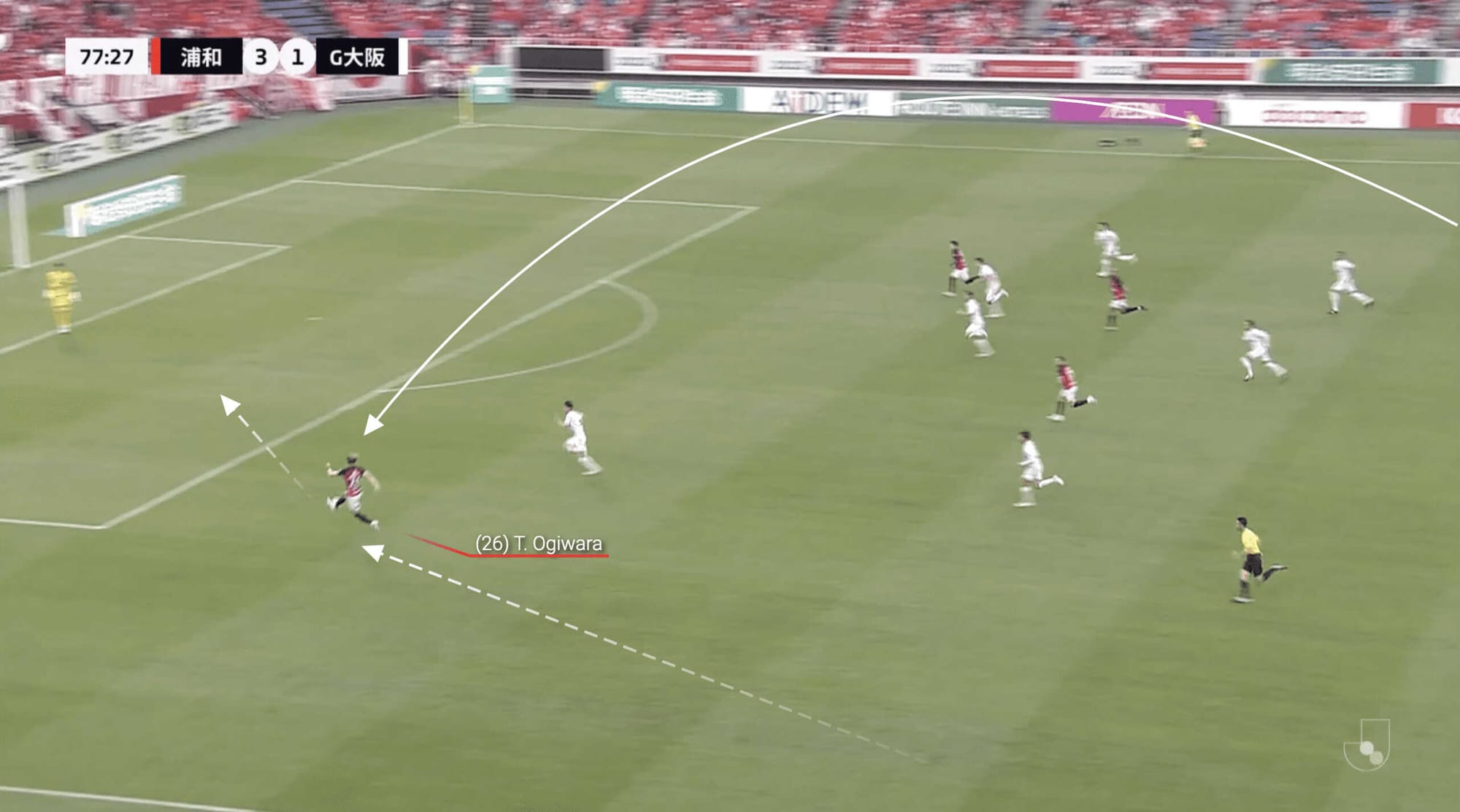
Here in Figures 2.6 and 2.7, we can see left-back Takuya Ogiwara making a line-breaking run that allows him to get in behind the opposition’s defensive line. Under Skorża’s direction, he has the freedom to push forward quickly and can take advantage of any open space left by the opposition. By joining the attack, he provides an extra option and stretches the opponent’s defence, creating opportunities to penetrate and create scoring chances. Furthermore, as we can see here, Ogiwara is able to control the long pass and then is through 1v1 with the goalkeeper.
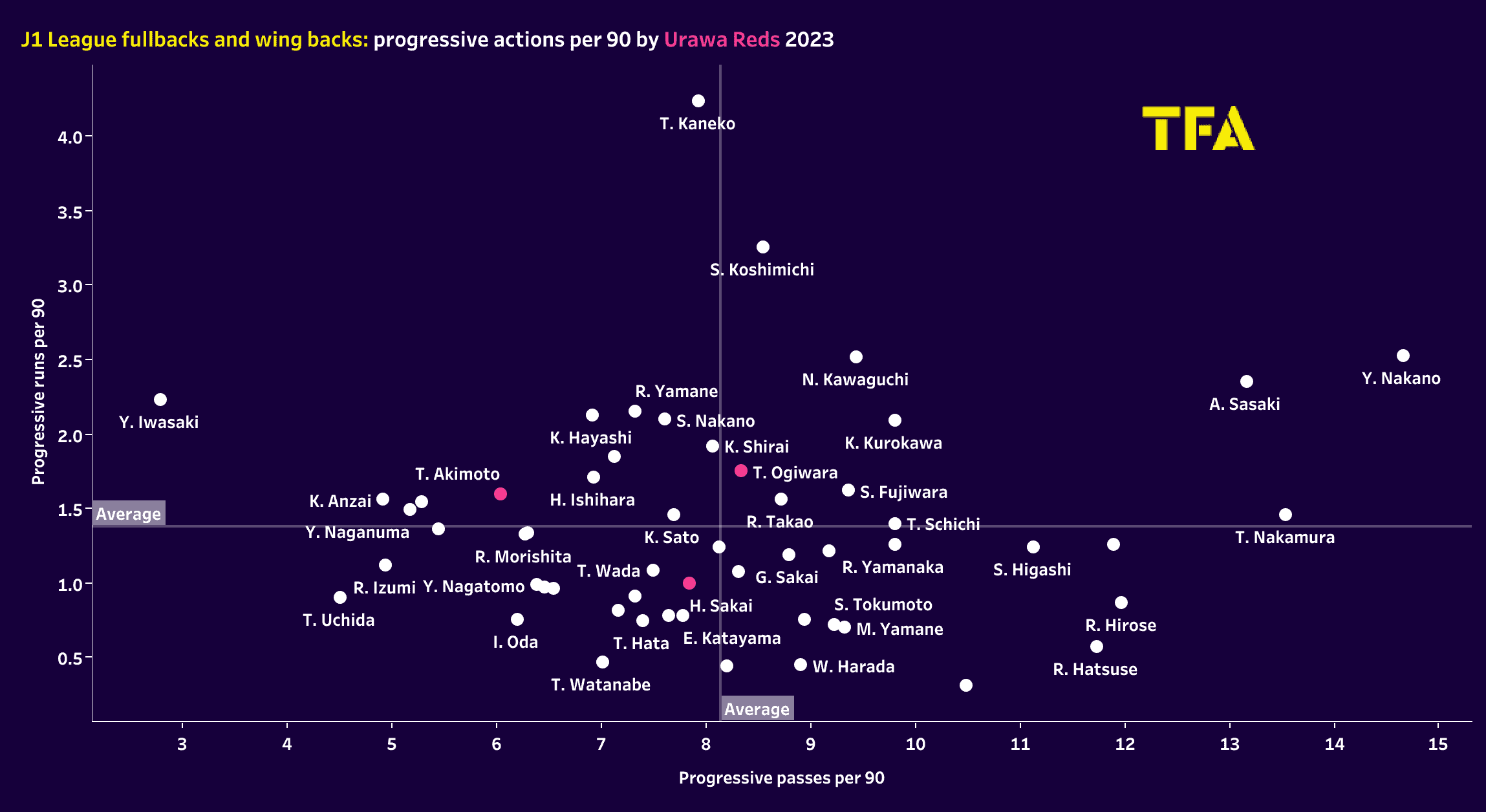
As we have observed, a significant portion of Skorża’s tactical style relies on the involvement of the fullbacks without the ball, particularly through their runs to create or exploit space. However, when comparing the Urawa Reds’ fullbacks to their peers in the J1 League, it becomes evident that they are not the most progressive in terms of their actions with the ball.
Ogiwara, for instance, averages 8.34 progressive passes per 90 and 1.75 progressive runs per 90. These statistics indicate that he is above average compared to other fullbacks in the league so far this season. On the other hand, Akimoto averages 6.04 progressive passes per 90 and 1.6 progressive runs per 90, indicating that he is slightly less progressive than Ogiwara when in possession.
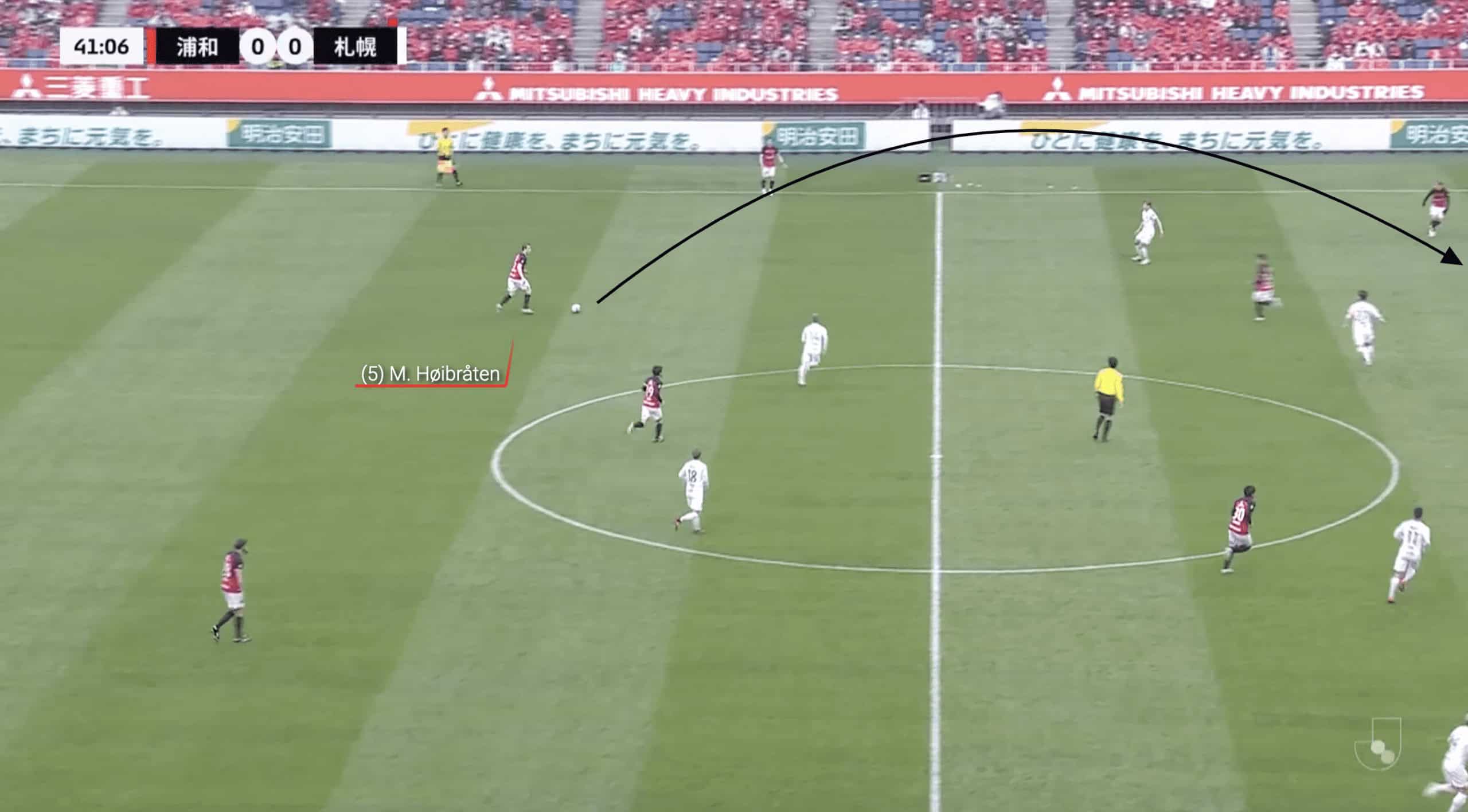
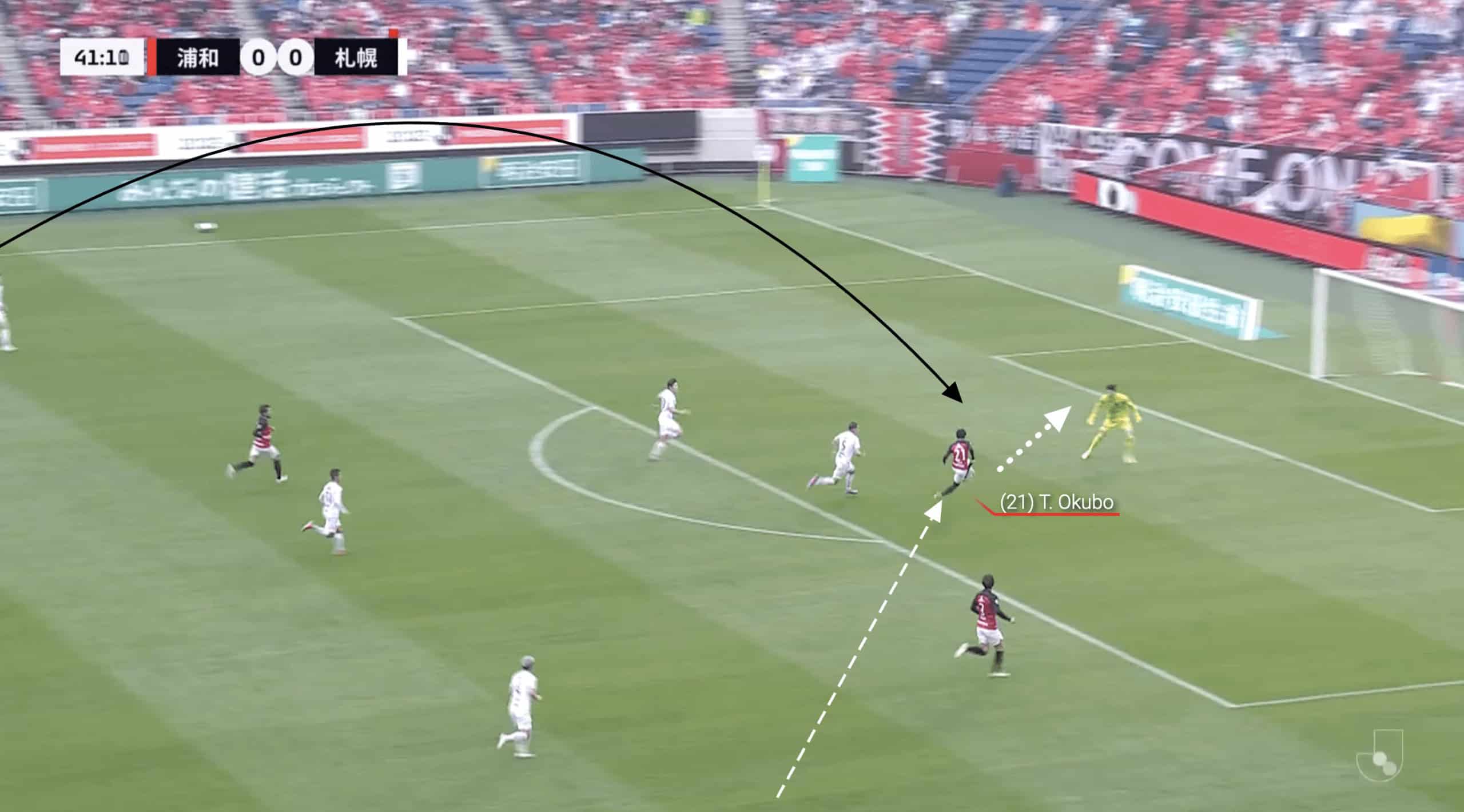
Additionally, it’s not only the fullbacks who make inverted runs, but the wide players also engage in this tactic to catch opponents off guard and swiftly break through defensive lines. In this particular example, Okubo makes a run inwards from the right wing, and Marius Høibråten executes a splendid ball over the top to find him. Consequently, Okubo finds himself in a 1v1 situation with the goalkeeper, presenting a promising opportunity to score.
Pin the opposition in their own half
Another key element of Urawa Reds’ play under Maciej Skorża is the way that they constantly look to push up incredibly high in order to pin their opponents deep into their own half. By pinning their opponents in their own half, Skorża’s team can gain better control of the game, therefore, it allows them to apply more pressure and dictate the tempo. When the opposition is constantly forced to defend, they have fewer opportunities to launch counterattacks or create scoring chances. This defensive pressure can lead to mistakes and turnovers, providing the team with opportunities to quickly transition into attack.
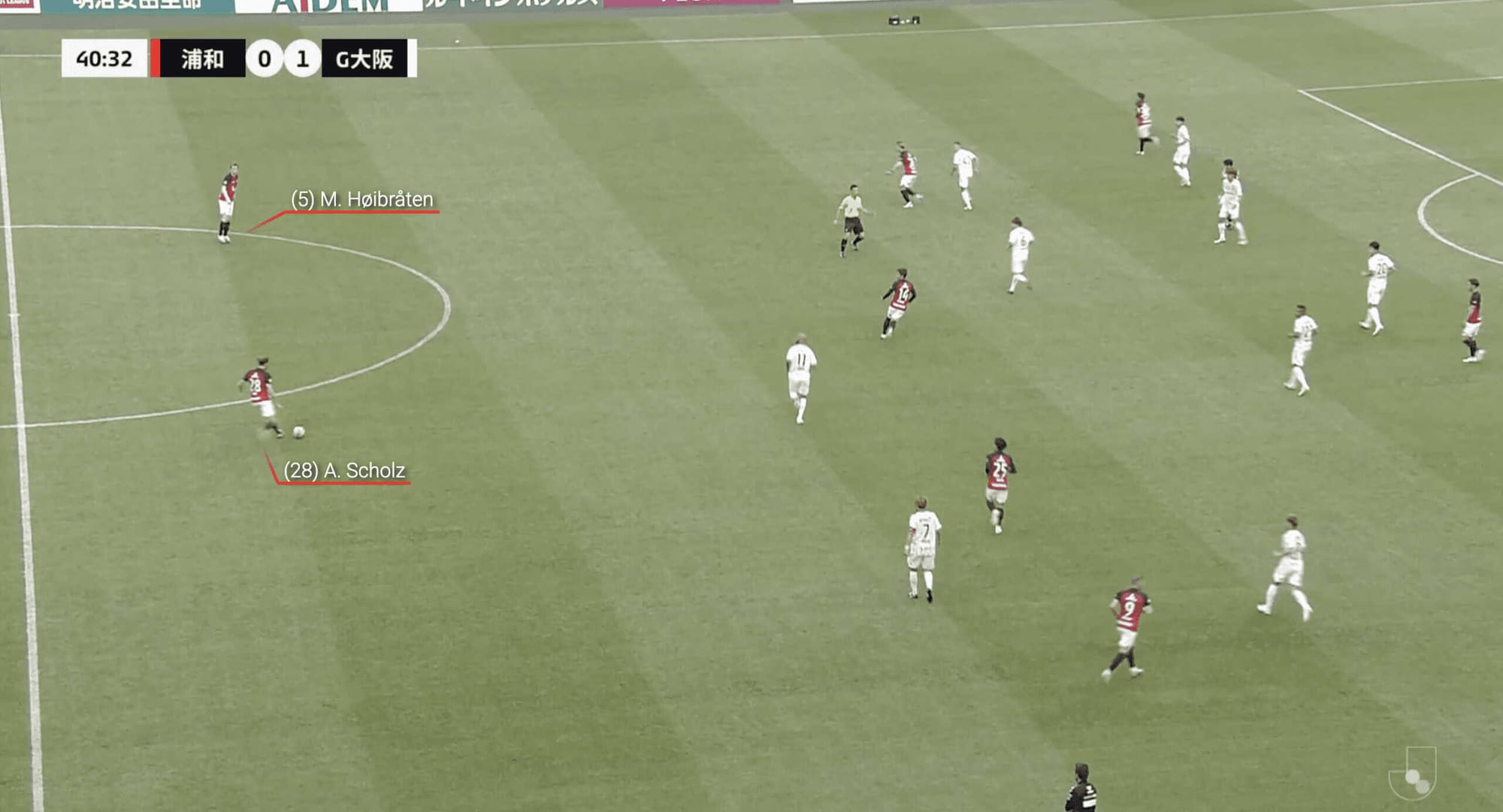
In Figure 3.1, it is evident how high the Urawa Reds’ defensive line pushes up. The central defenders, Scholz and Høibråten, are positioned as the furthest players back and are well into the opposition’s half. This strategic positioning effectively reduces the available playing space, making it exceedingly challenging for the opposition to break out of such a compact area.
Besides preventing the opposition from breaking out, when Urawa Reds push higher up the pitch, they gain better access to second balls and loose balls in the opposition’s half. This enables them to maintain sustained pressure, quickly regain possession, and launch immediate attacks. The centre-backs moving further into the opposition half also contribute to the team’s attacking options by providing additional passing choices and supporting the midfield and forward lines.
In the J1 League, Urawa Reds have an average PPDA of 11.74, indicating that they are not an extremely high-pressing team but it is still effective nonetheless. However, this number does represents a significant difference from what we witnessed in the AFC Champions League.
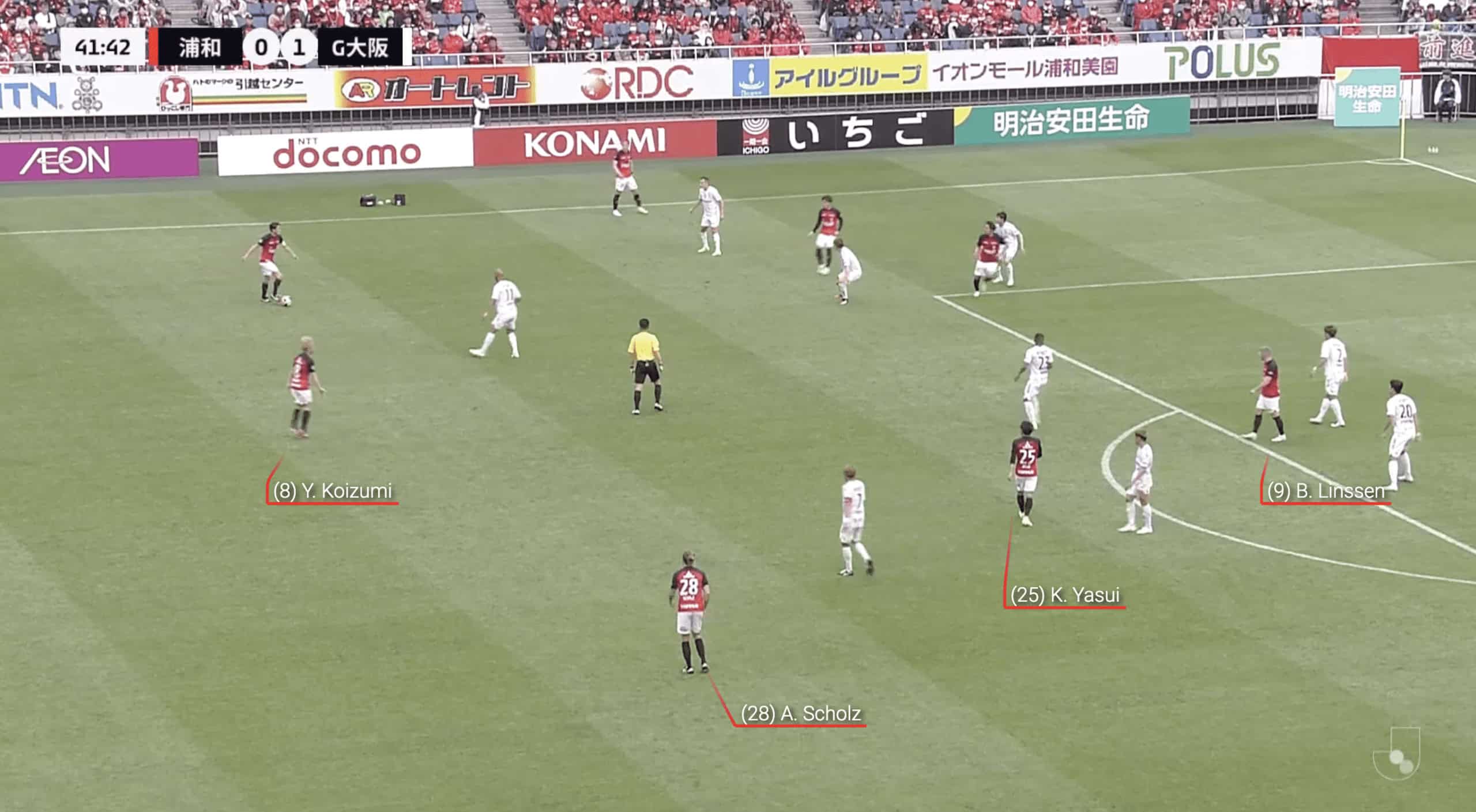
In this example, we can see that Scholz is extremely high up. This is not uncommon in Skorża’s tactics. Very often there will only be one centre-back who remains a little deeper to provide cover, Høibråten being that player in this case. We can also see that Urawa have almost encircled their opponents, this allows the players to make small off-the-ball movements in order to play intricate passes through the lines. Additionally, this means it is incredibly difficult for their opponents to regain possession and counterattack.
Whilst Urawa are not the most high-pressing team in the league, in situations such as this, when they lose possession they are quickly able to cut off any available passing lanes and force turnovers.
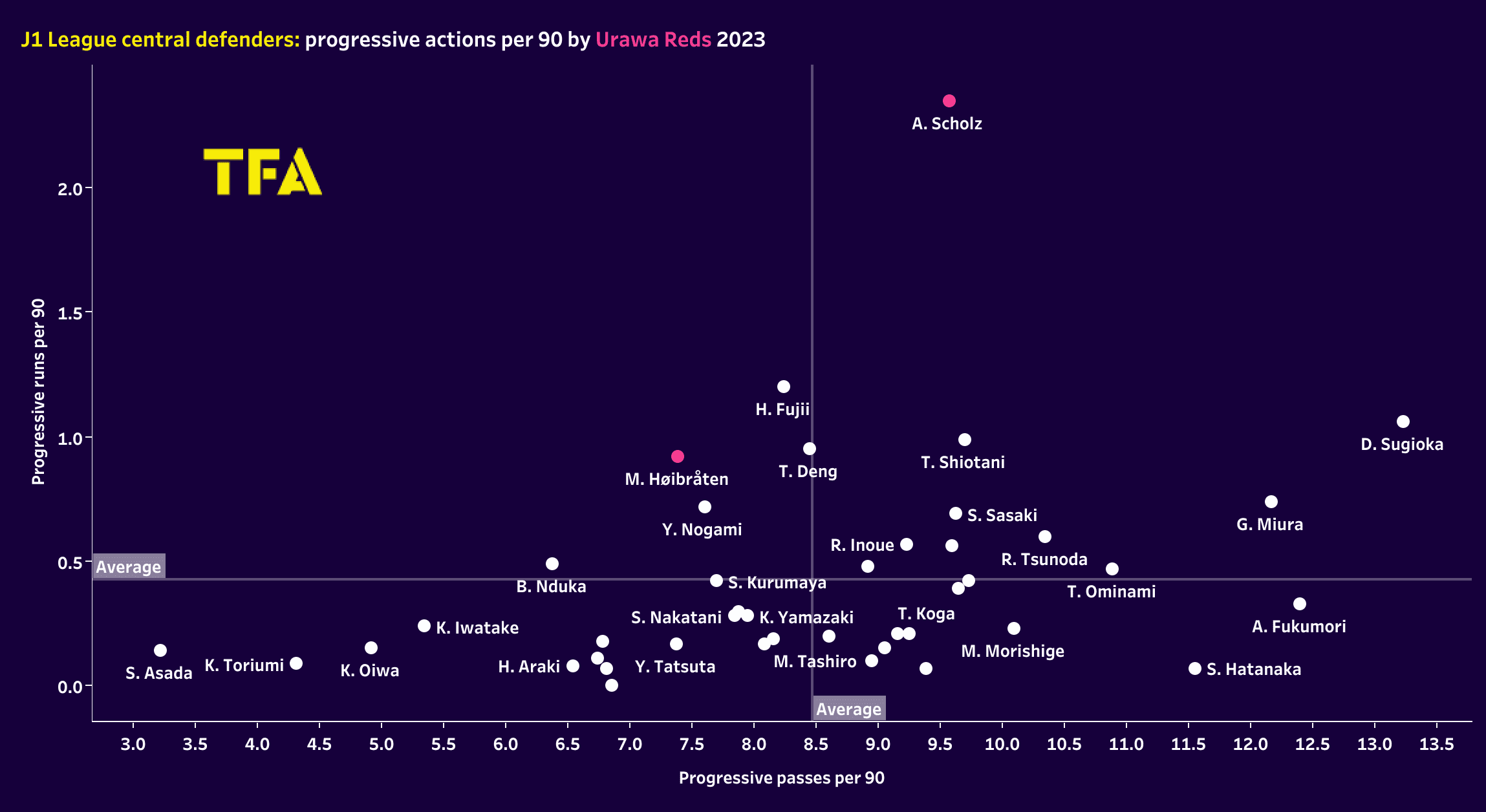
As mentioned above, when Urawa Reds push higher up the pitch, they gain better access to second balls and loose balls in the opposition’s half. It allows them to maintain sustained pressure, win back possession quickly, and launch immediate attacks. The centre-backs moving further into the opposition half can contribute to the team’s attacking options by providing additional passing options and supporting the midfield and forward lines.
The data visual above shows us that Skorża has two very good central defenders at his disposal. We can see that Scholz is a standout in terms of his progressive actions, with 9.57 progressive passes per 90 and 2.35 progressive runs per 90. He will often receive the ball and carry it well into the opposition half before searching out a teammate.
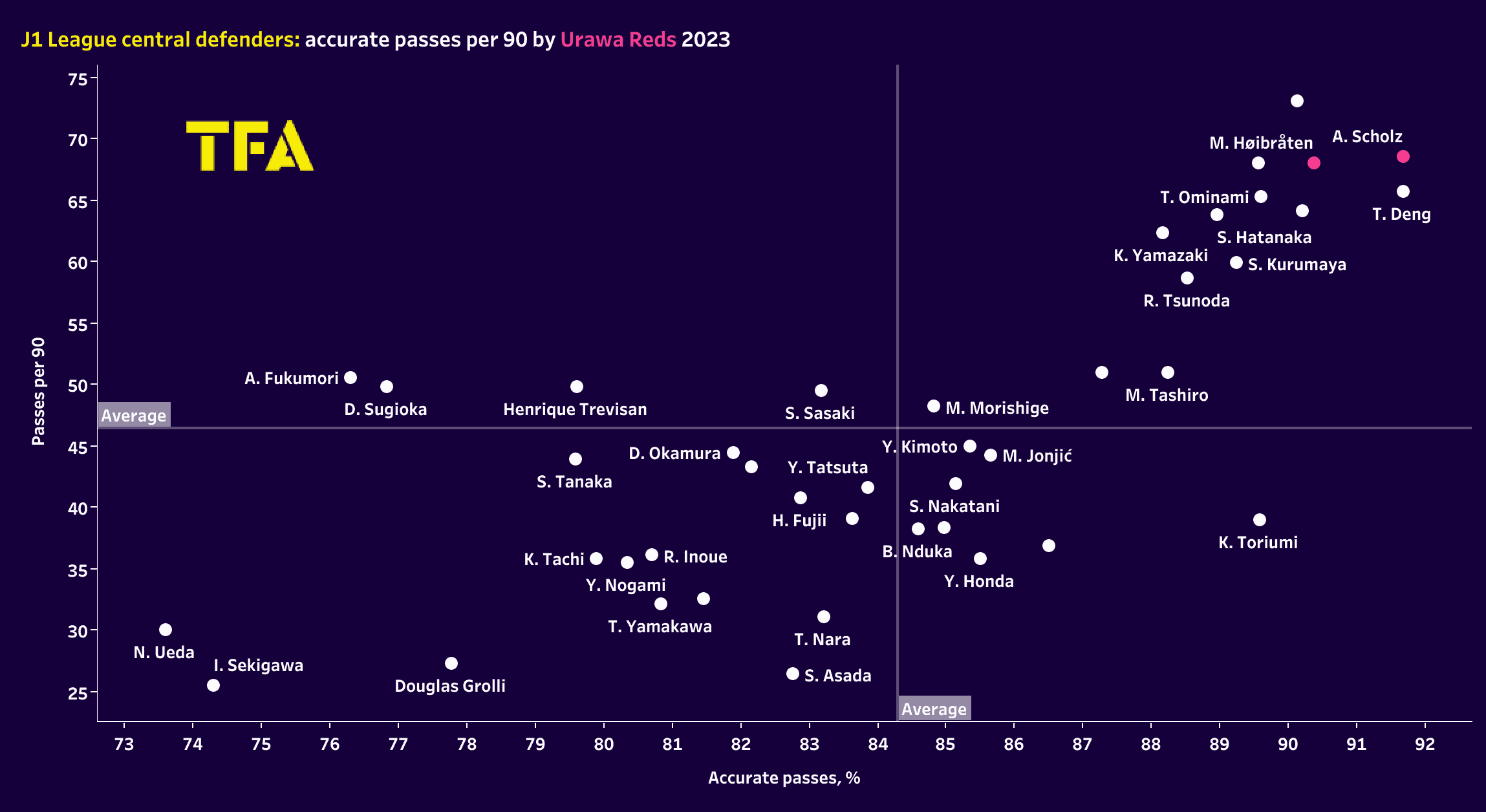
In order to play this way, both defenders need to be reliable in possession otherwise they risk losing the ball and giving the opposition a chance to launch a counterattack. From this data visual we can see that both central defenders are among the most accurate passers in the league, as well as completing the most passes per 90.
Høibråten averages 68 passes per 90, with an accuracy rating of 90.37%, similarly, Scholz averages 68.59 passes per 90 with an accuracy rating of 91.68%. Both players are very good ball-playing defenders who are more than capable of playing Skorża’s desired style.
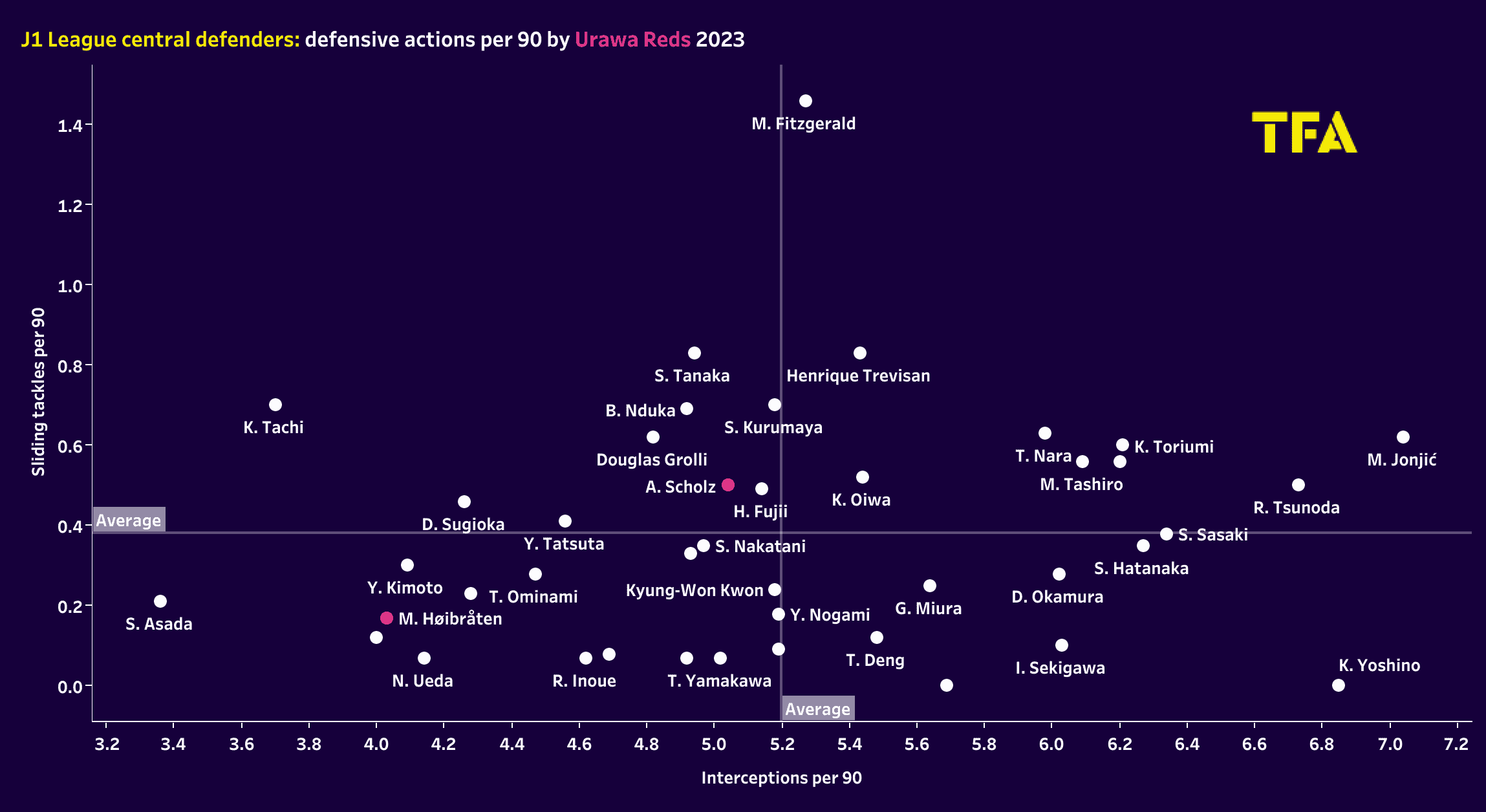
This data visual shows us the number of defensive actions taken by the central defenders per 90. We can see that Scholz averages 5 interceptions per 90 which is below average compared to fellow J1 League central defenders. However, he is above average in terms of sliding tackles per 90 which indicates some elements of ‘last ditch’ defending going on.
Høibråten on the other hand is below average in both interceptions and sliding tackles indicating a potential vulnerability for the team. These shortcomings could expose Urawa to increased attacking threats and create opportunities for opponents to exploit gaps in the defence.
Indeed, an alternative explanation for this observation could be that the Urawa Reds’ tactical style, which focuses on pinning their opponents back and quickly regaining possession, limits their defensive workload. As a result, Urawa may not have to engage in as much defensive work as teams with a different approach. This can result in fewer defensive actions, such as tackles or interceptions. Of course, they are very susceptible to the counterattack which we will discuss later in this tactical analysis.
Target the wide areas
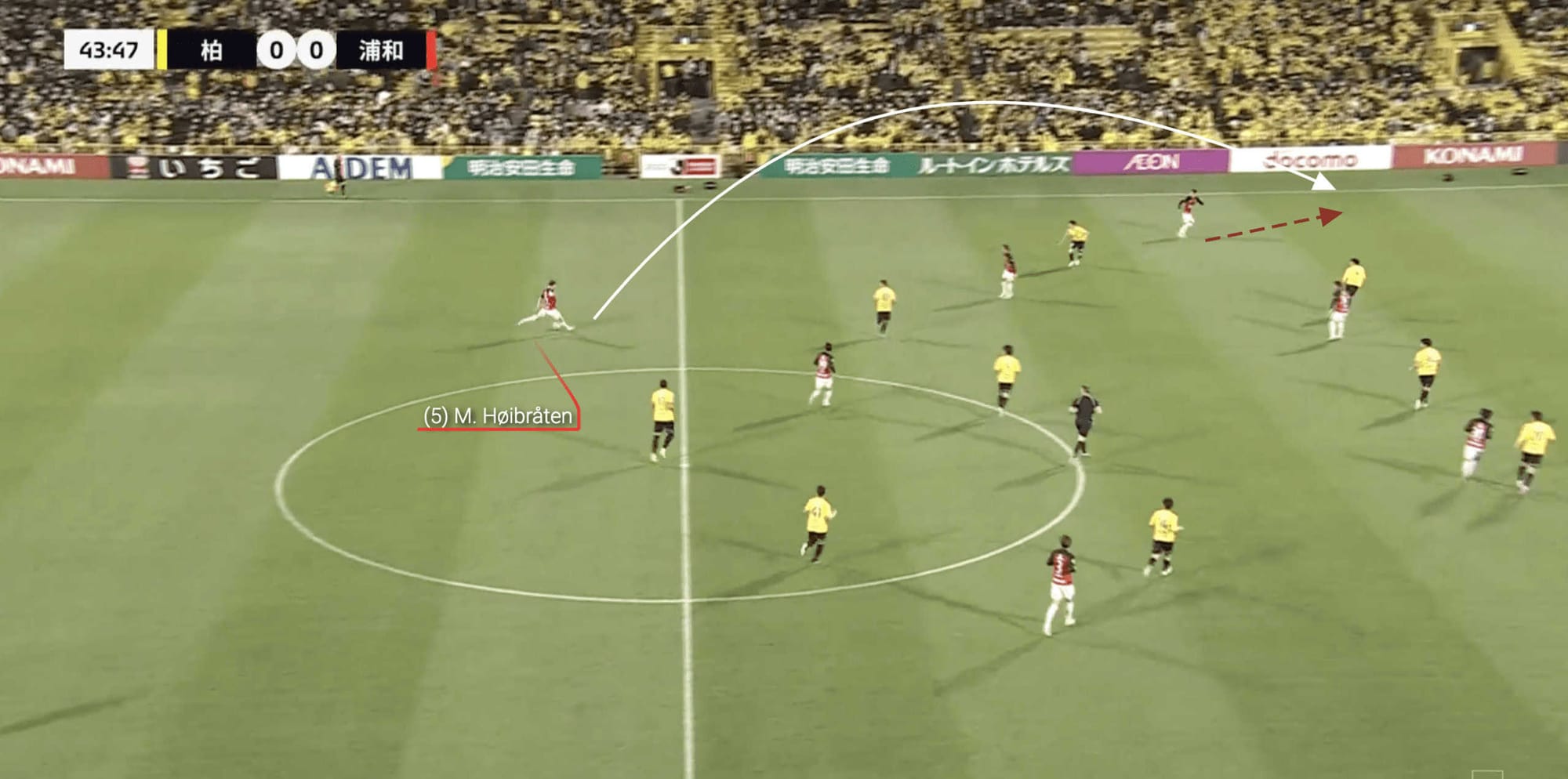
In addition to the inverted runs from fullbacks and wingers, Urawa will look to use the wide areas to progress the play quickly and effectively. Utilising wide areas allows teams to stretch the opposition horizontally. By spreading out the play, Urawa creates more space for their attacking players to operate in. This forces opposition defenders to cover a larger area, making it harder for them to maintain a compact shape and close down passing lanes effectively. Therefore, this spatial advantage provides opportunities for the team in possession to exploit gaps in the defence.
We can see here in Figure 4.1, Høibråten looks to spread the play out into the left wing. Then, Urawa has plenty of space as the opposition defenders are preoccupied with the two attackers in the central area which of course means there is more space out wide.

In Figure 4.2, we can see that Koizumi has carried the ball forwards and as he looks to play the ball out wide, a space opens up for him due to the defence wanting to prevent the counterattack. As a result, upon releasing the ball, Koizumi has the opportunity to continue his run forward into the attacking third.
Counterattack vulnerabilities
We have seen that Urawa Reds commit a large number of players to the attack, which naturally leaves fewer players in defensive positions. This reduces the defensive cover and the team’s ability to quickly transition from attack to defence. With fewer players available to track back and cover defensive positions, there are more spaces and gaps left behind, which can be exploited by the opposition on the counterattack.
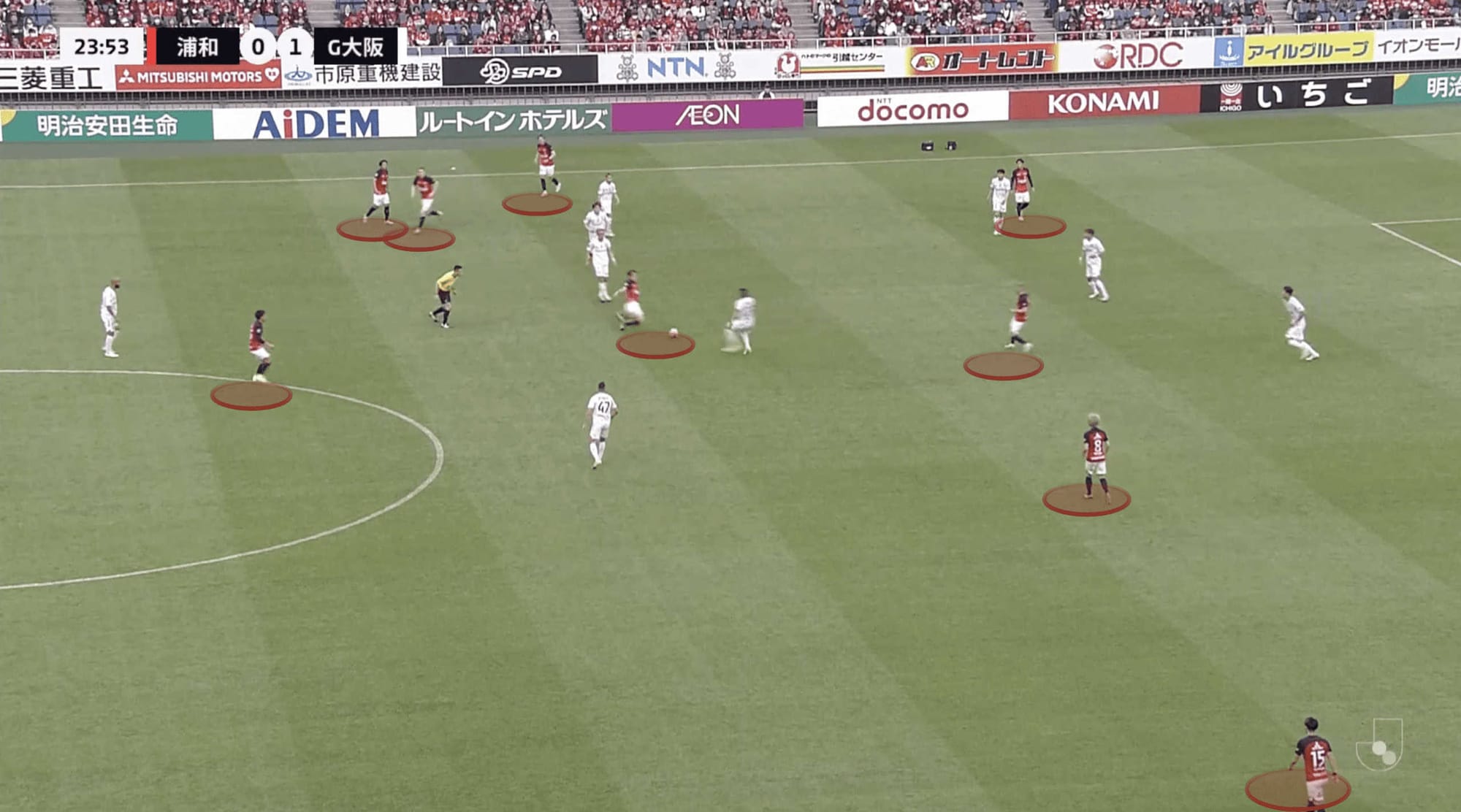
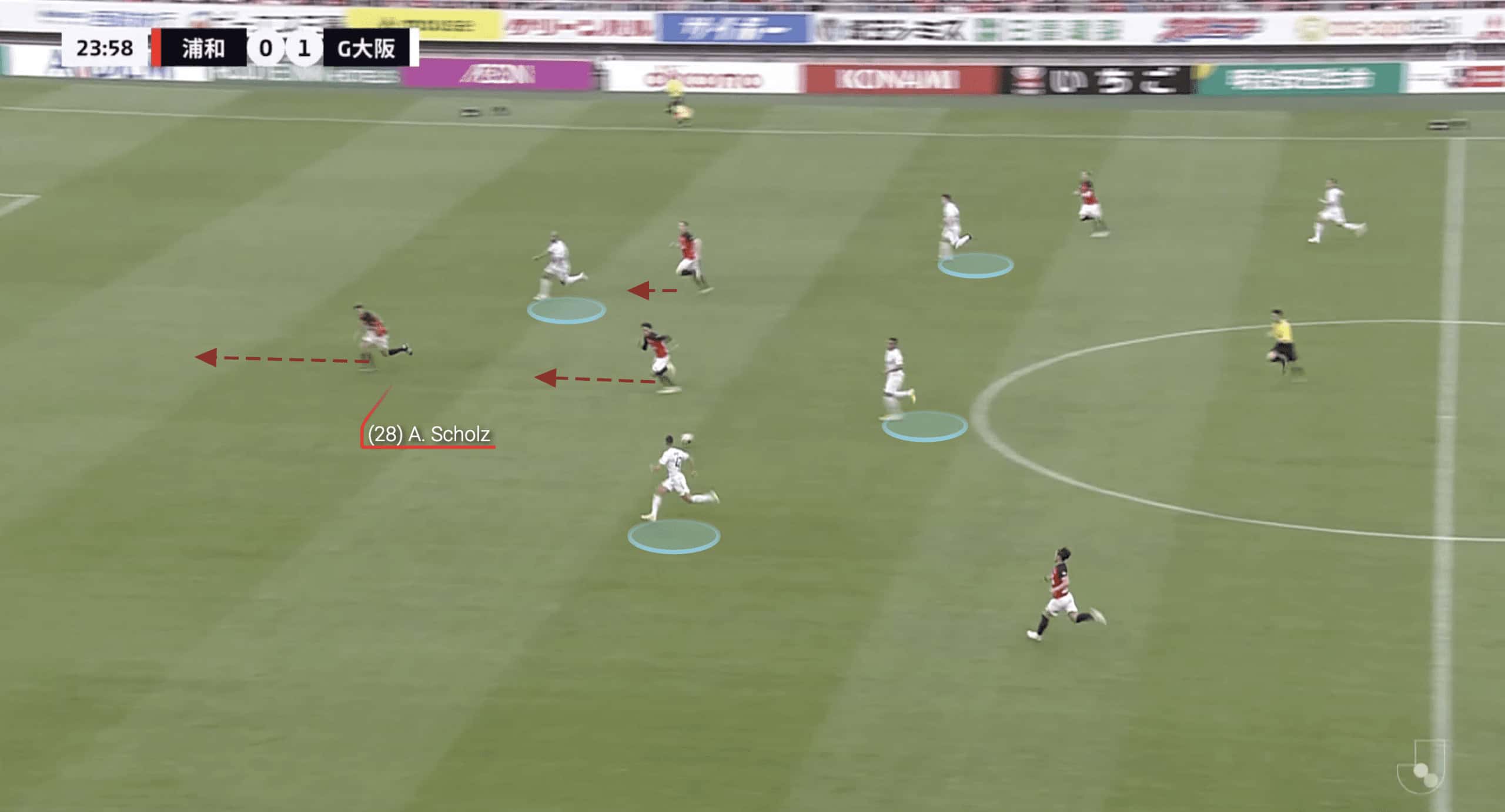
For example, here in Figure 5.1, we can see there are nine Urawa players in the opposition half. They lose possession and the opponent is able to launch a counterattack with relative ease due to the fact that there are only two covering defenders.
In Figure 5.2, we can see how the counterattack progresses, to Urawa Reds credit, they do track back relatively quickly but it is rather a high-risk strategy that can lead to a number of goalscoring opportunities being conceded. However, with only 11 goals conceded in the league so far this season, Skorża will be pleased that his team manages to make their recovery runs incredibly well in order to prevent the opposition from finding the back of the net.
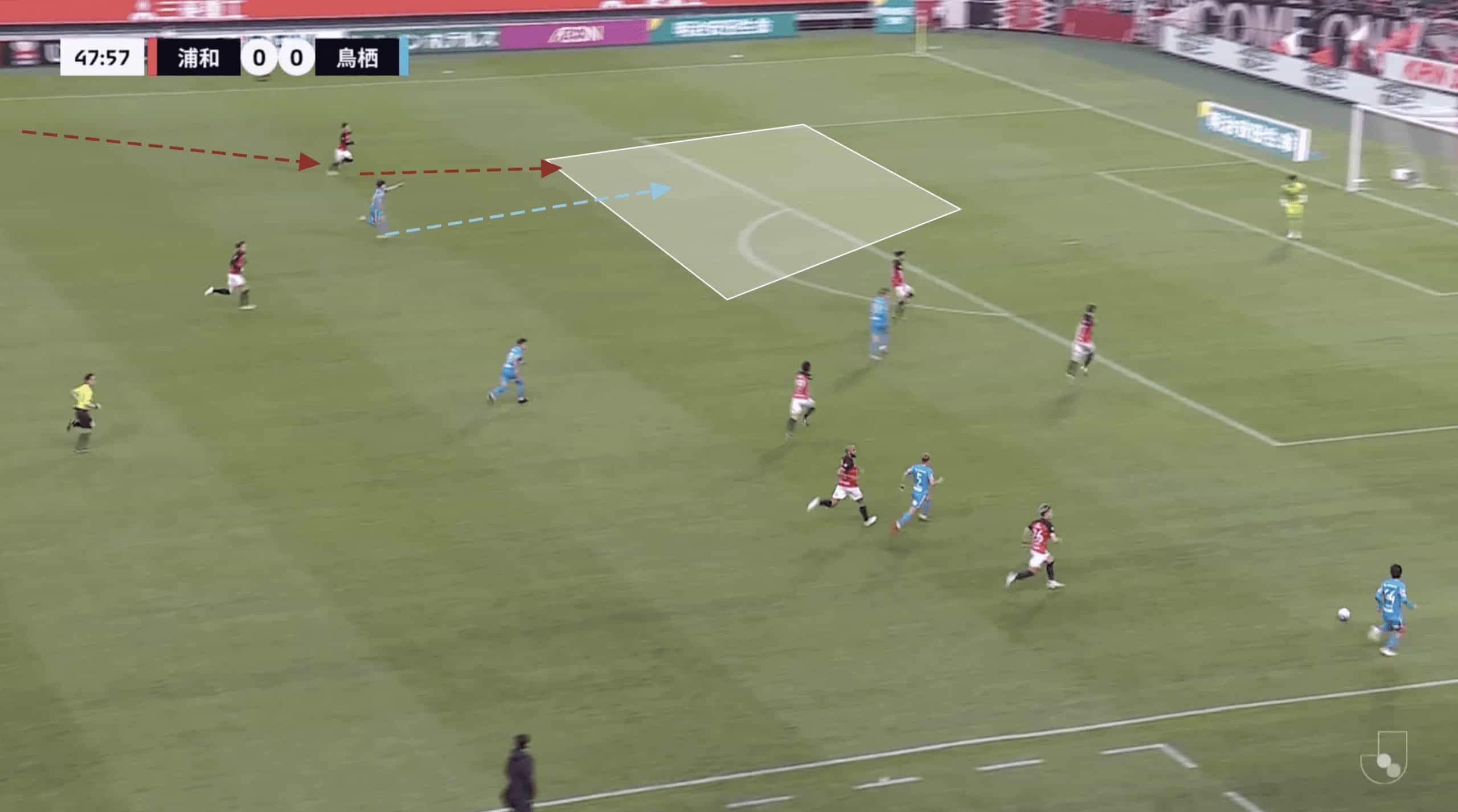
Figure 5.3 depicts a similar scenario, Urawa has lost possession and their opponents have been able to counterattack. We can see that due to the fullbacks charging forward, there is plenty of space in the wide areas. In this particular situation, one well-placed cross could completely evade the central defenders and reach the player making a run into the highlighted area, who has time and space due to the fullback being unable to track back quickly enough.
A lack of goals
For all their free-flowing attacking football, Skorża’s team have really struggled to find their goal-scoring form this season.
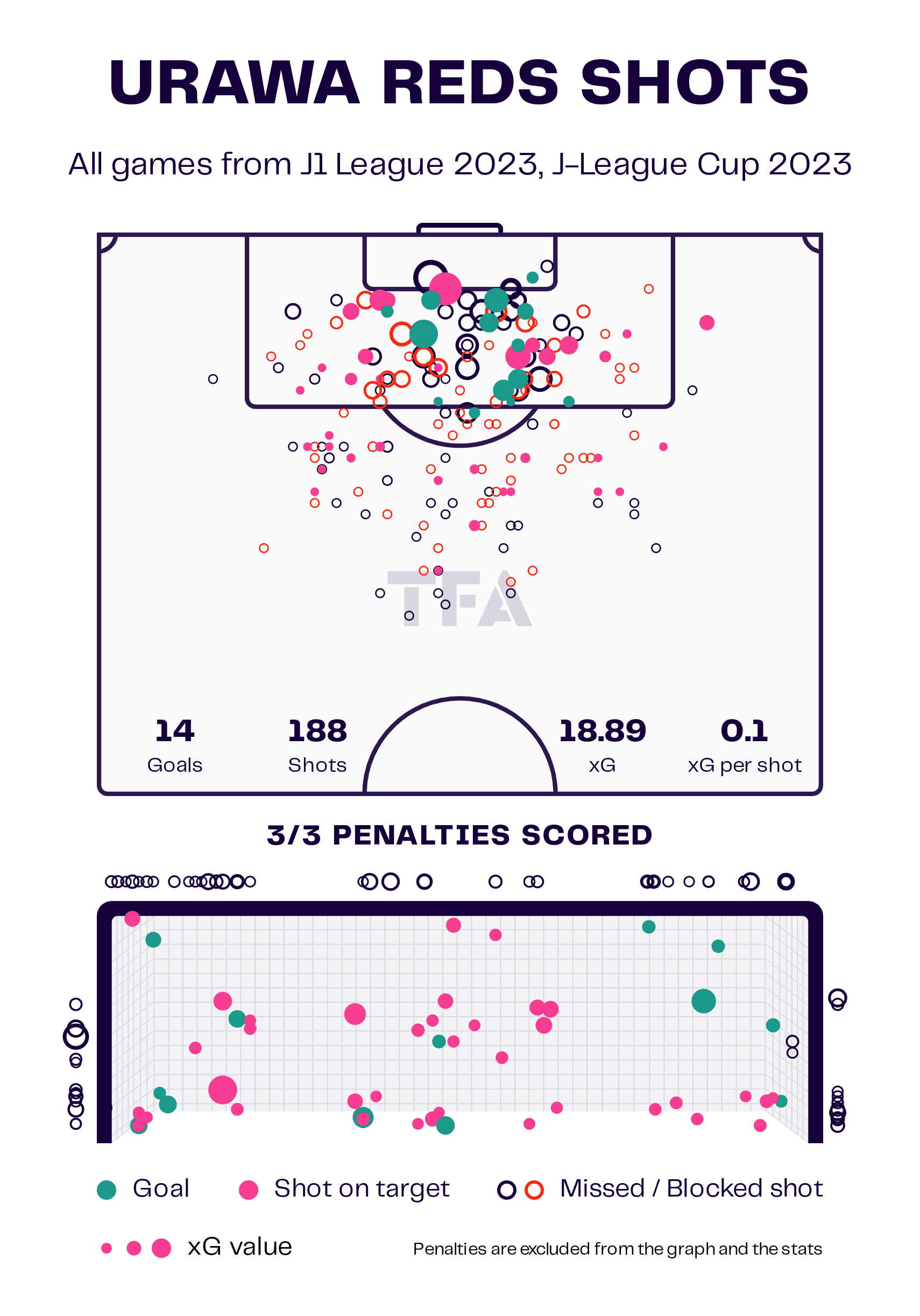
The data visual above shows us how Urawa Reds have been underperforming their xG in the league and cup this season. They have scored 17 goals in total including 14 non-penalty goals, from an xG of 18.89. This represents a significant underperformance, one that could be incredibly decisive later in the season.
One possible reason for underperformance is poor finishing. Despite creating high-quality scoring opportunities, the team’s players may struggle to convert those chances into goals. Technical deficiencies in shooting or decision-making, or facing exceptional goalkeeping performances from the opposition could attribute to this. In such cases, the team may generate a high xG but fail to capitalise on those opportunities due to subpar finishing.
We have seen previously how Urawa like to push up incredibly high and pin their opponents back into their own half. Whilst this allows The Reds time to carve out opportunities, the quality of those opportunities can be questionable due to the sheer number of players in such a small area. If the opposing team defends compactly, organises well, and effectively blocks shots or limits the attacking team’s space in the penalty area, it becomes challenging to convert scoring chances into goals.
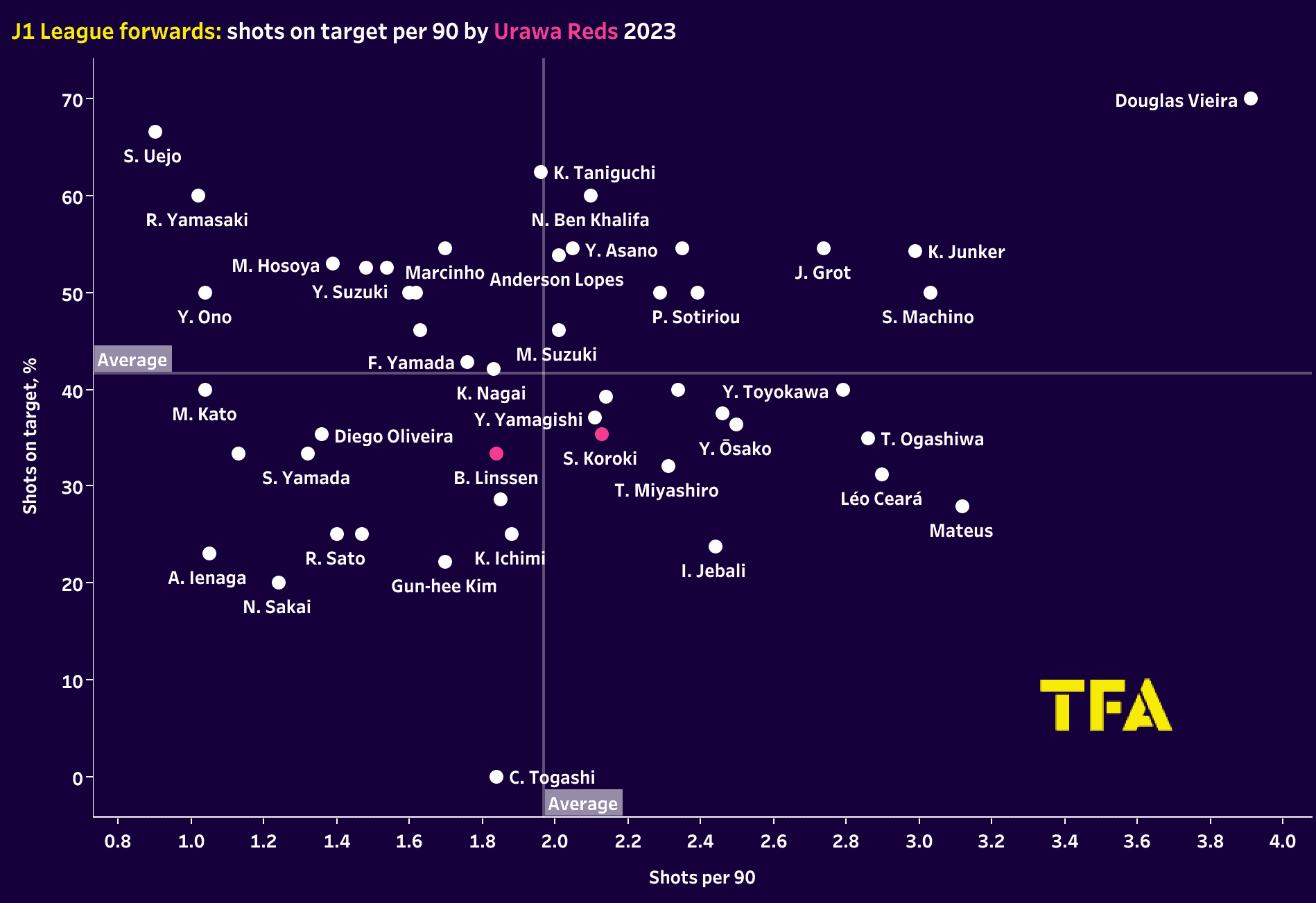
This data visual shows us the percentage of shots on target compared to the number of shots per 90 of the forwards in the J1 League. Koroki, who has scored three goals so far this season, has a slightly above-average number of shots per 90 but is below average in terms of how many of those shots are on target. Whereas Bryan Linssen is below average in both metrics. This suggests that neither forward is being provided with enough opportunities to be efficient in front of goal.
Urawa may become more clinical as the season continues, if not, this could be a worrying area that Skorża may need to address.
Conclusion
In conclusion, in order to secure victory in the AFC Champions League final, Skorża made a strategic decision to sacrifice his attacking principles which resulted in a successful outcome that greatly pleased the Urawa Reds fans.
Overall, Maciej Skorża has a penchant for playing an attacking game, sometimes even adopting an all-out attacking approach, allowing his players to showcase their creativity. However, in the case of Urawa, we have witnessed instances where the final ball has been lacking or the forwards have struggled to find the back of the net.
While the team has experienced a somewhat turbulent start to their league campaign, Skorża has implemented an attacking style of play that, when successful, is a delight to watch. Nevertheless, as highlighted earlier, there are weaknesses that need to be addressed and refined as the season progresses. It will be intriguing to observe the evolution of Skorża’s tactical choices over time.

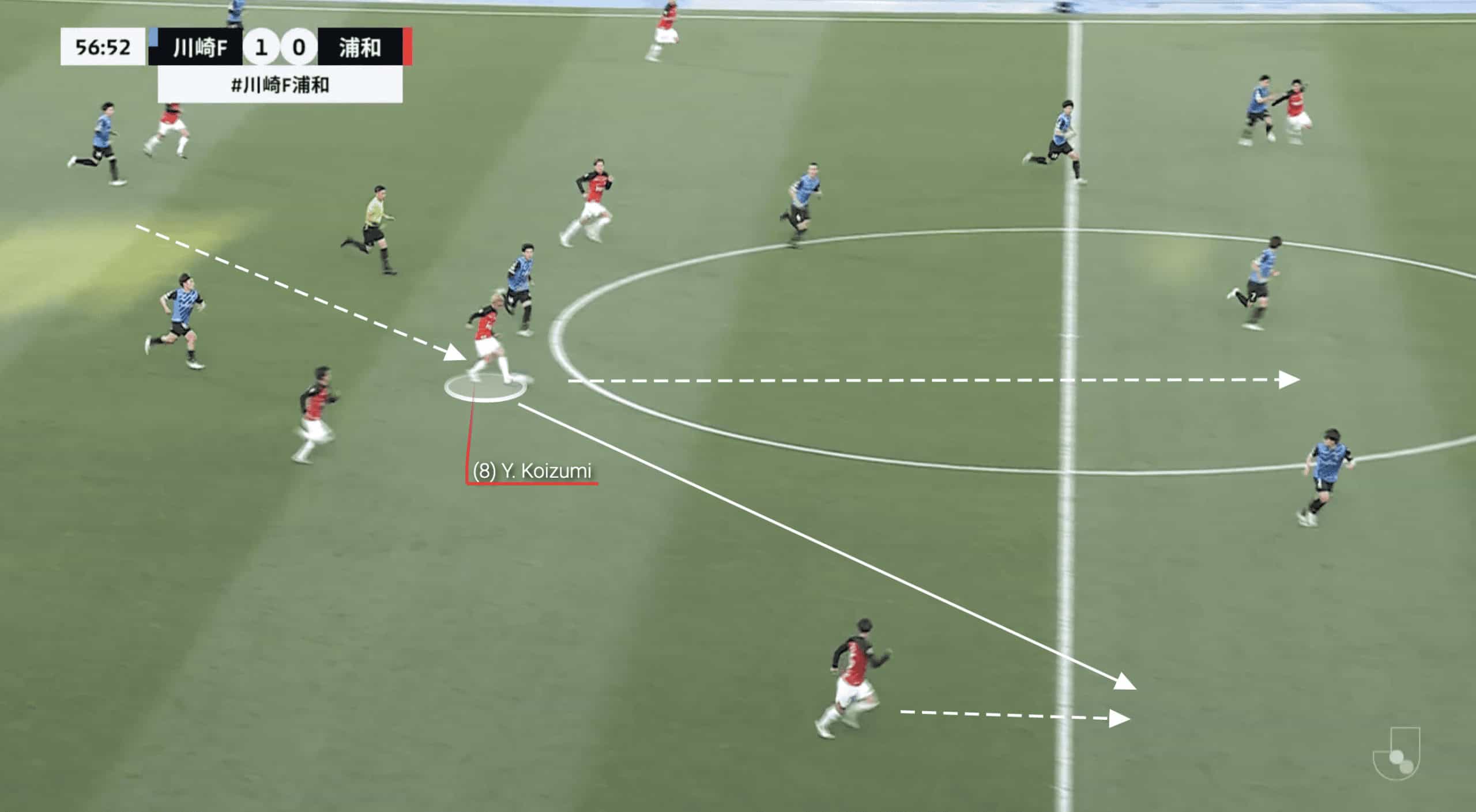



Comments